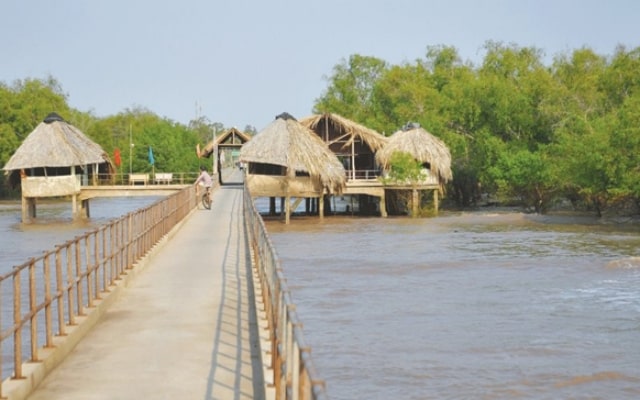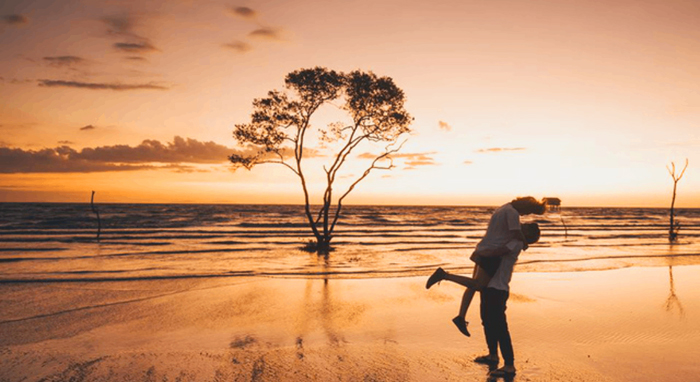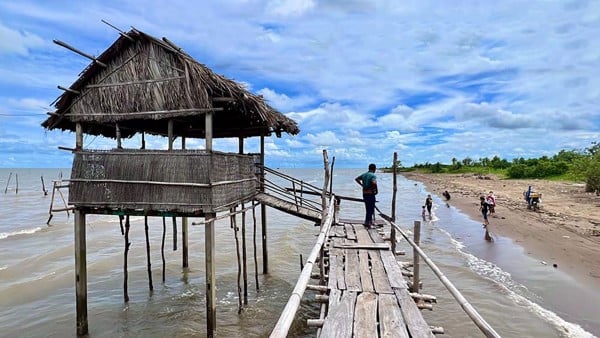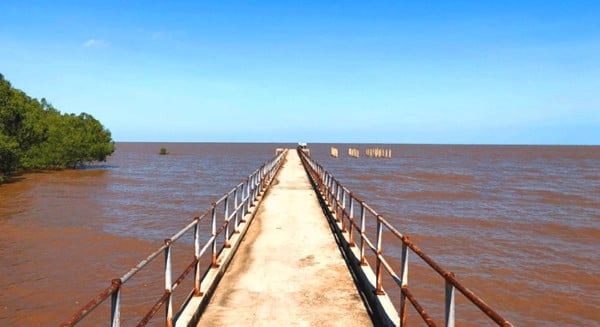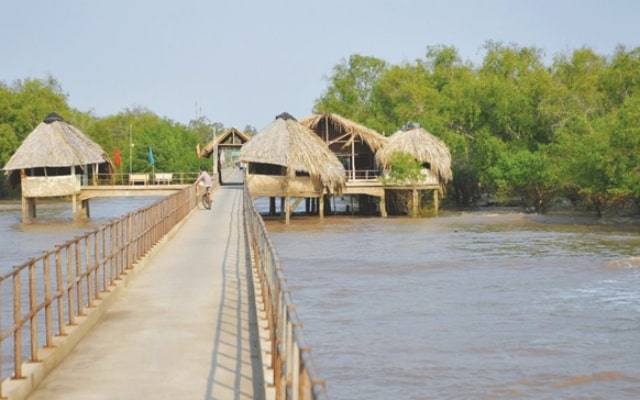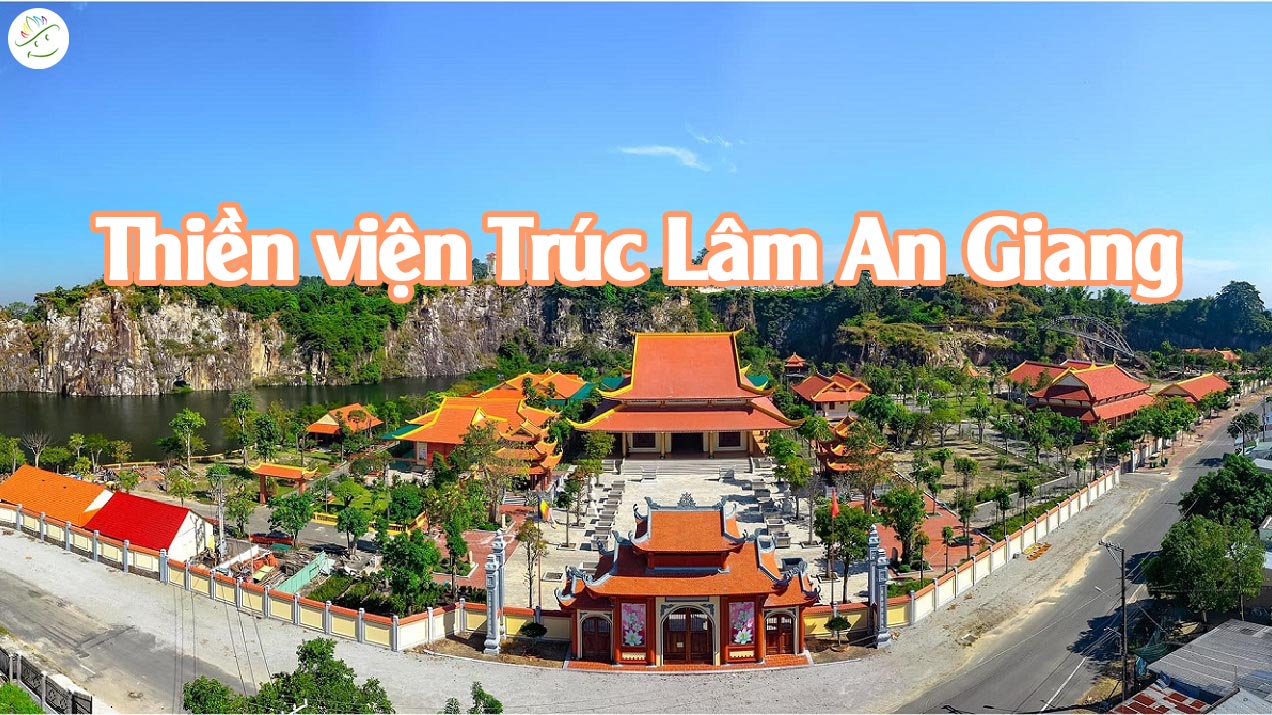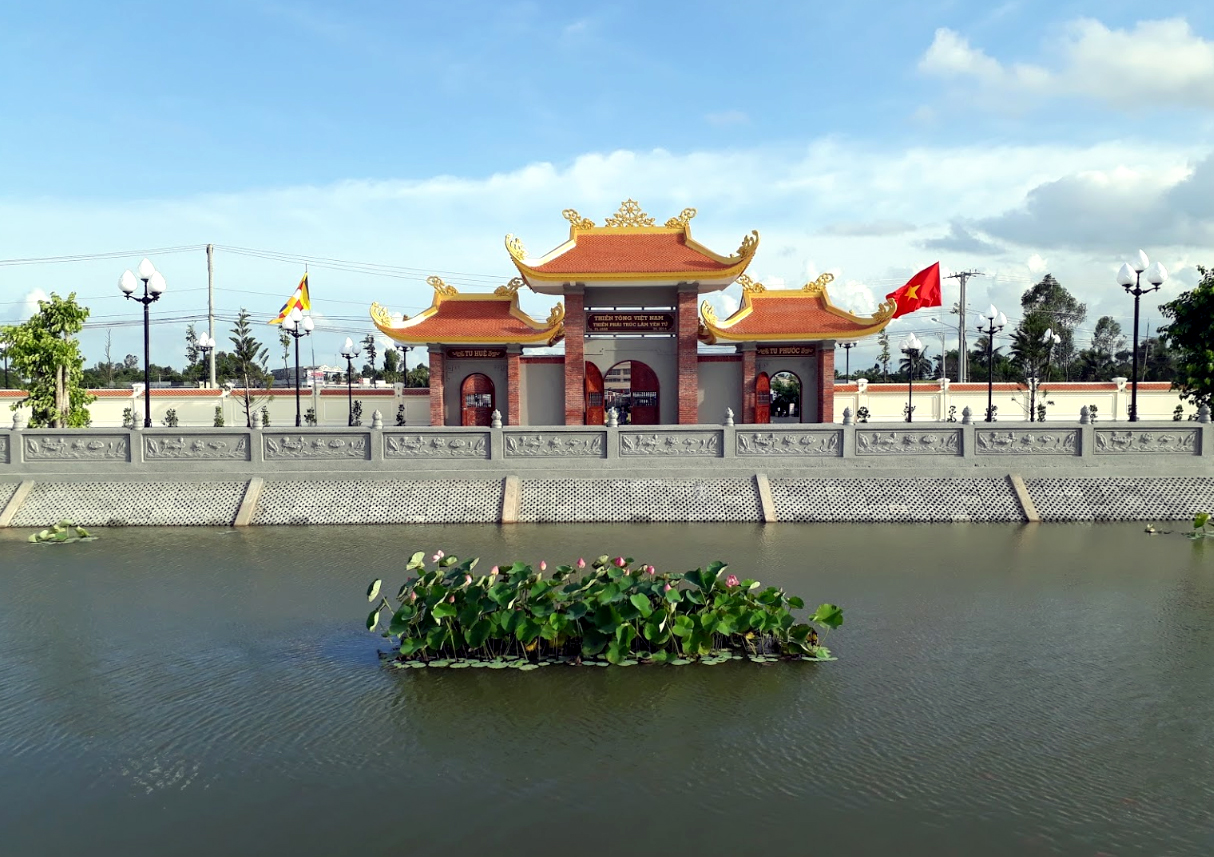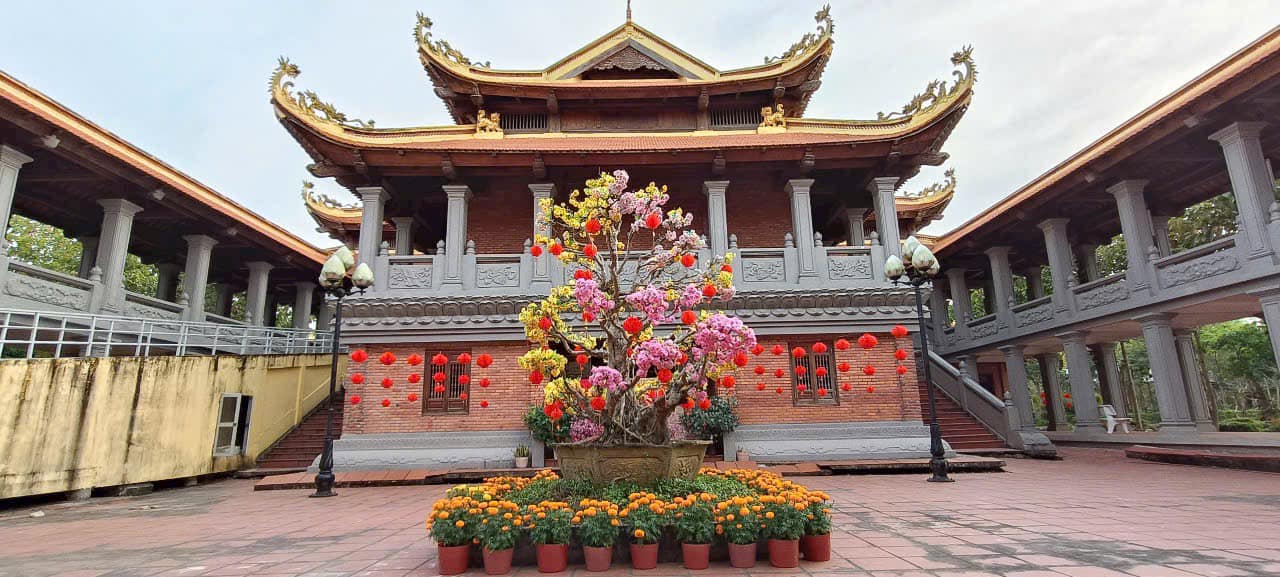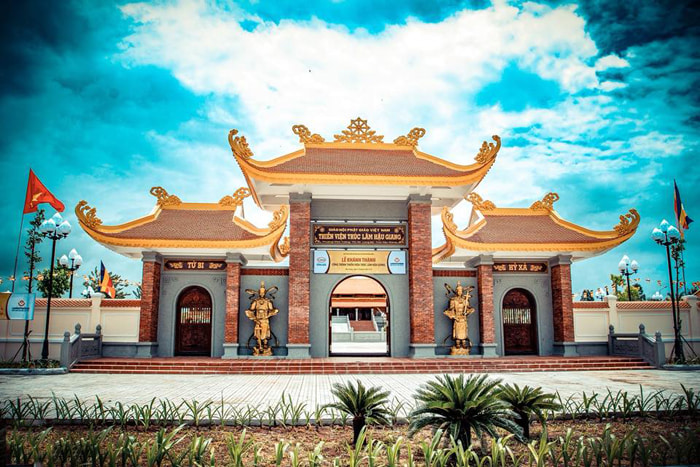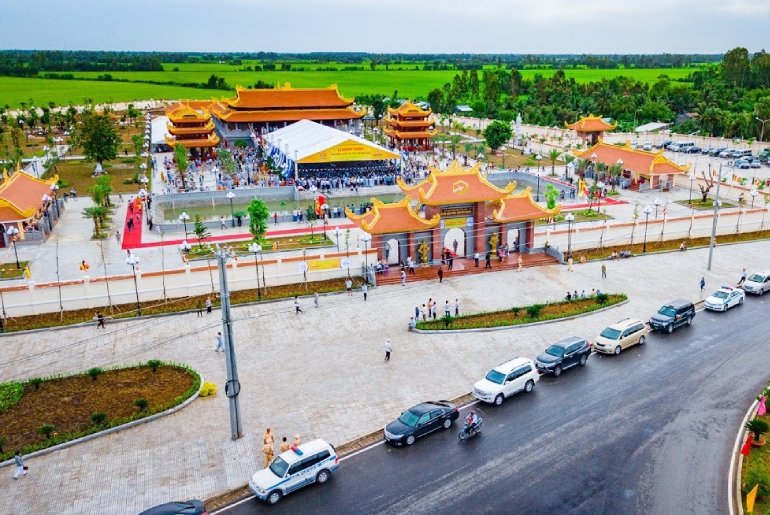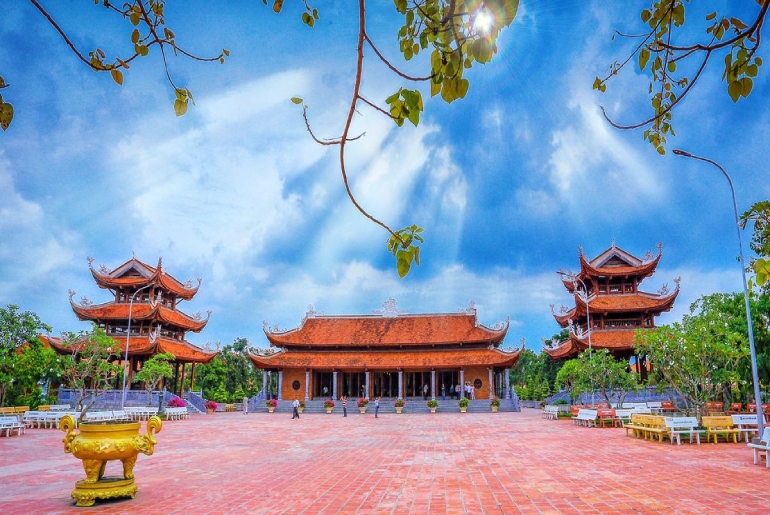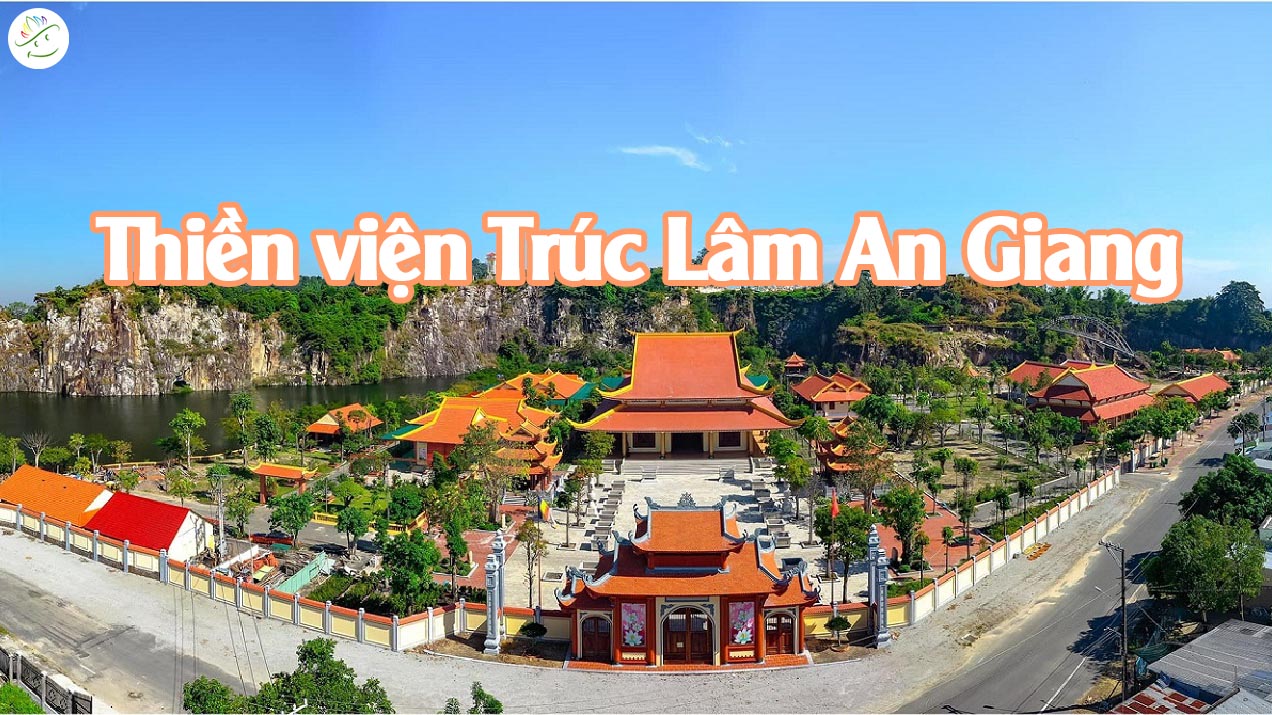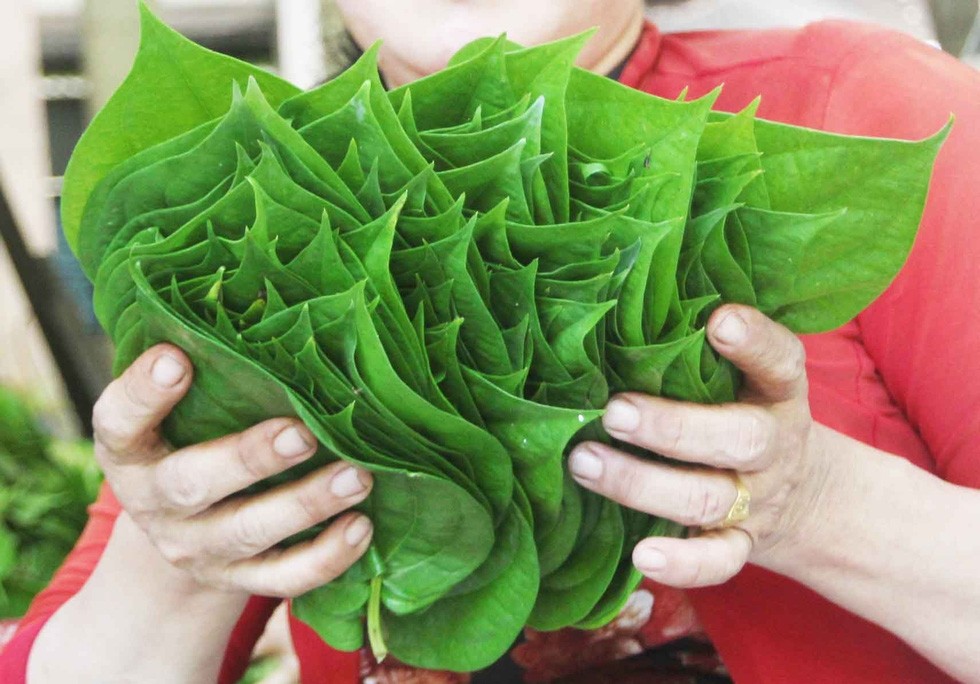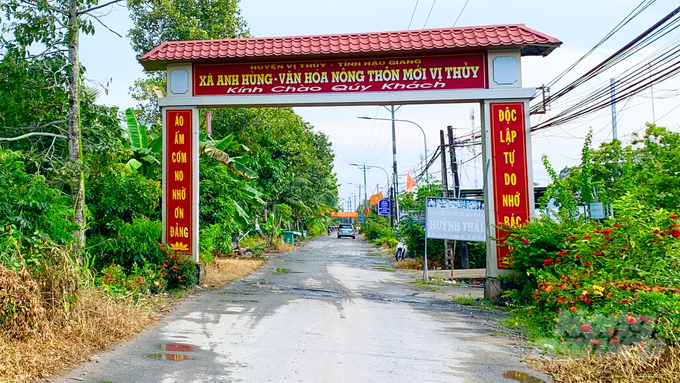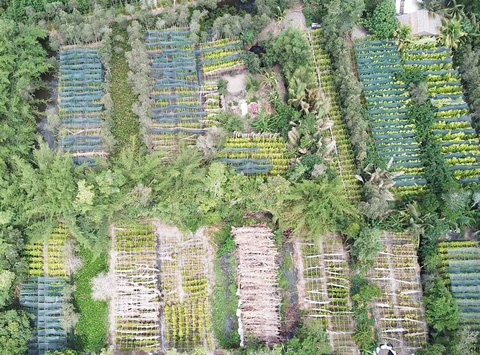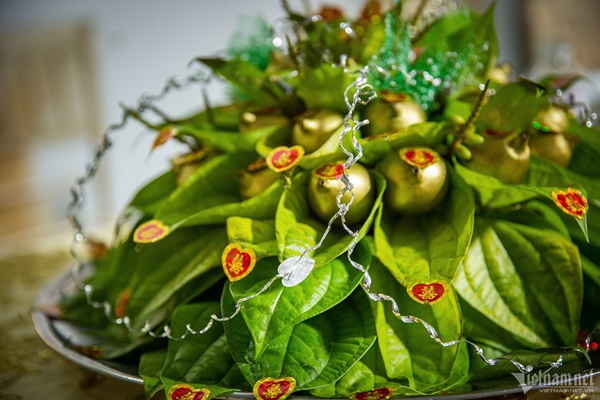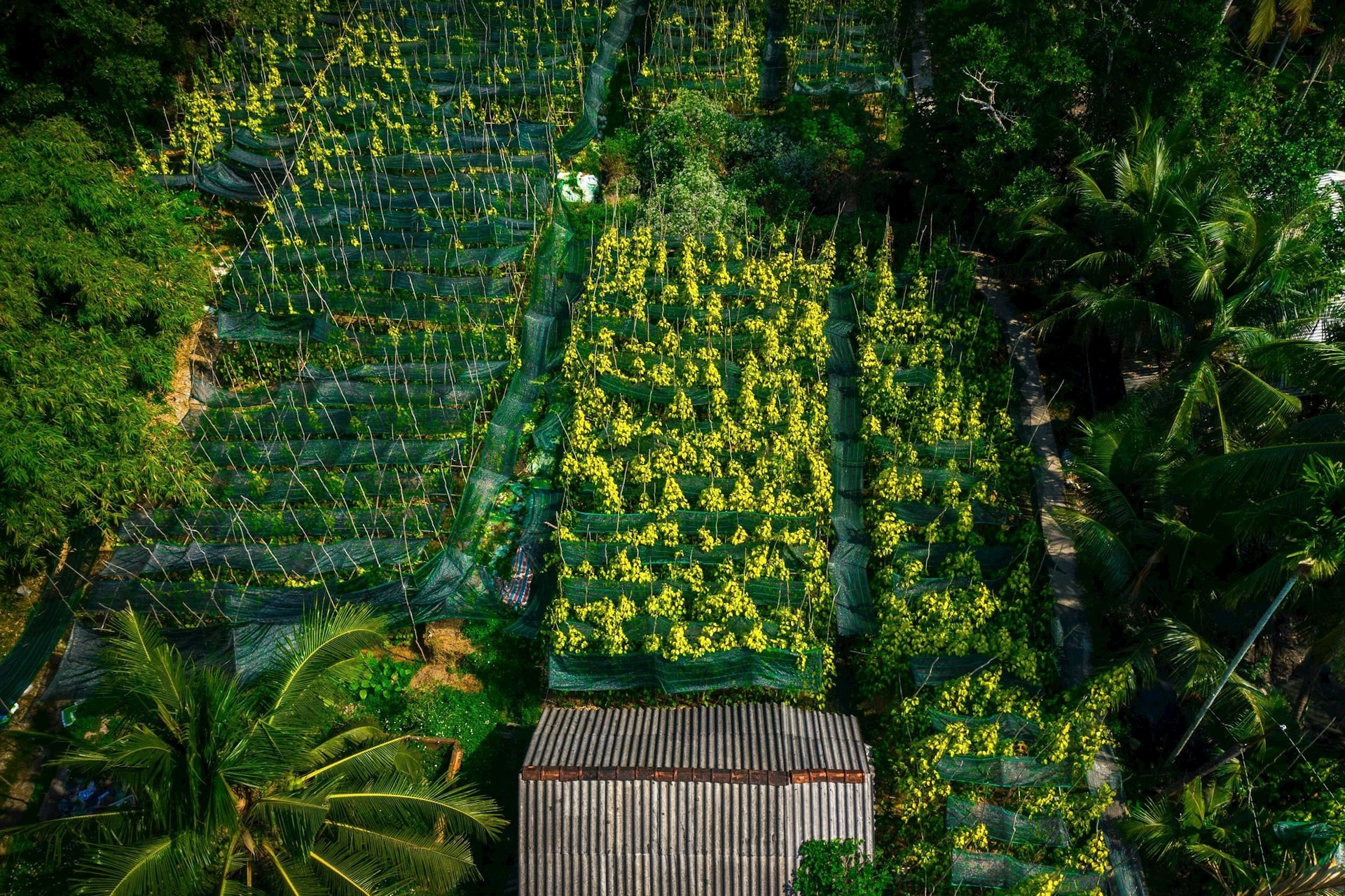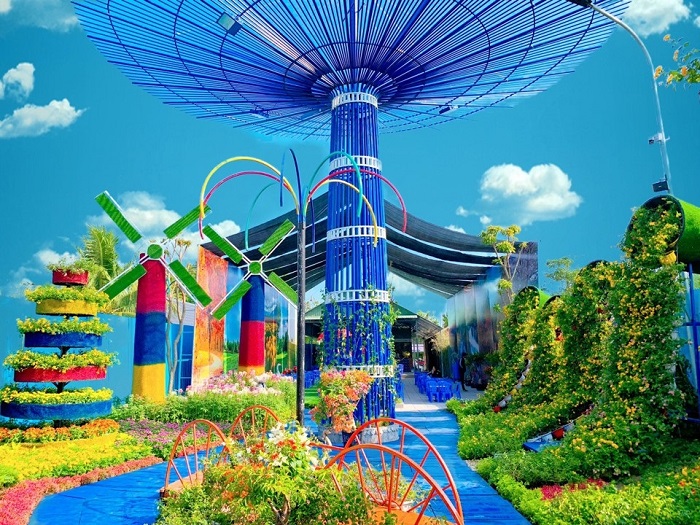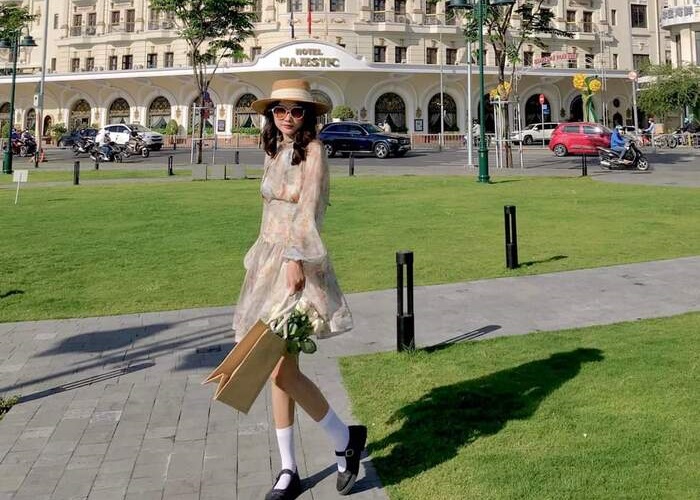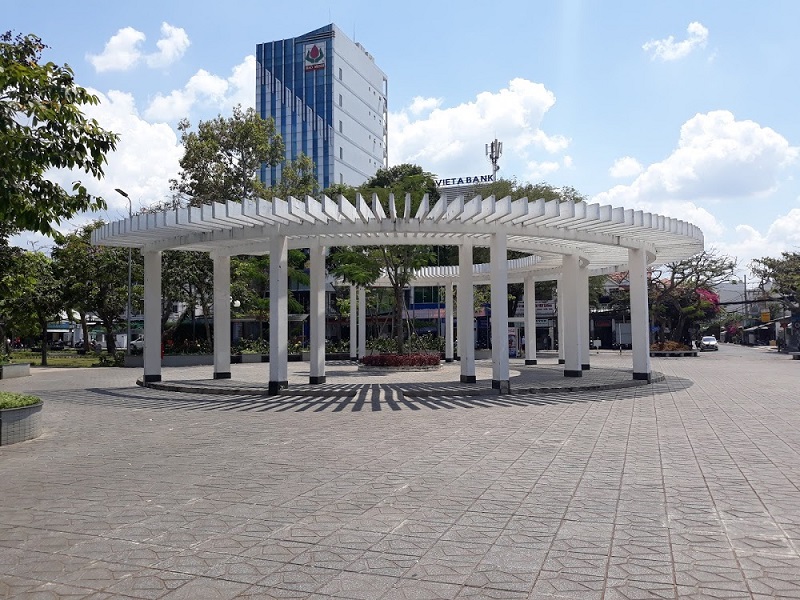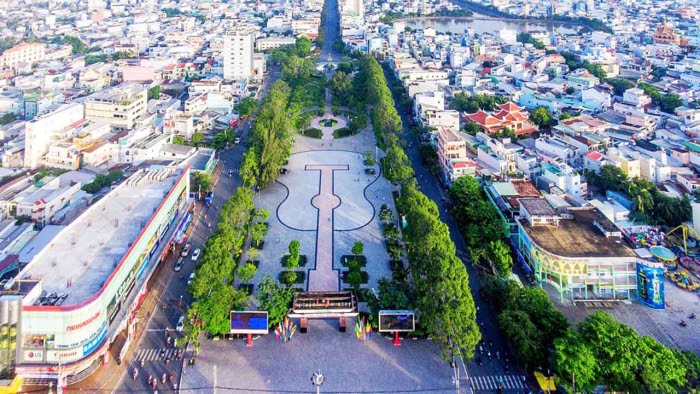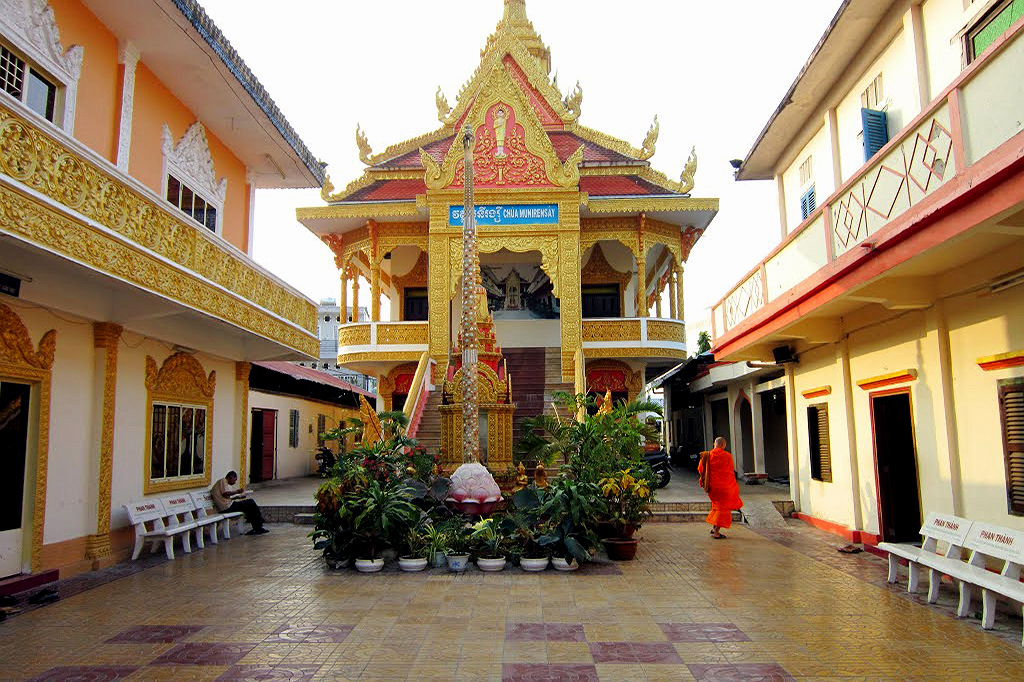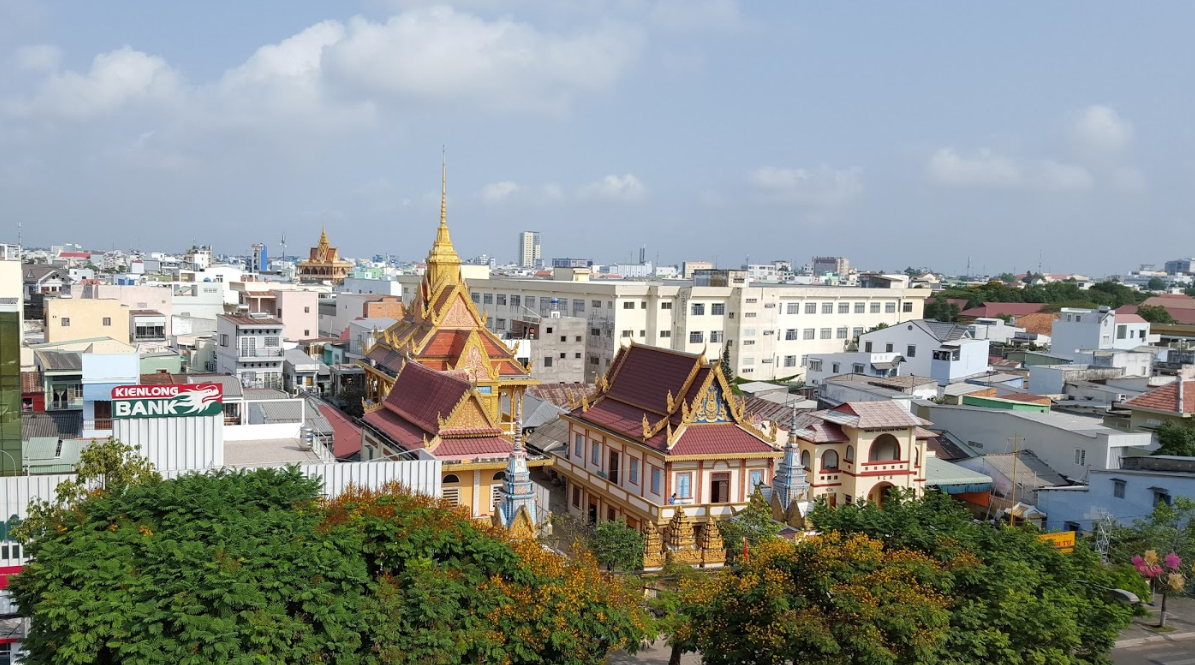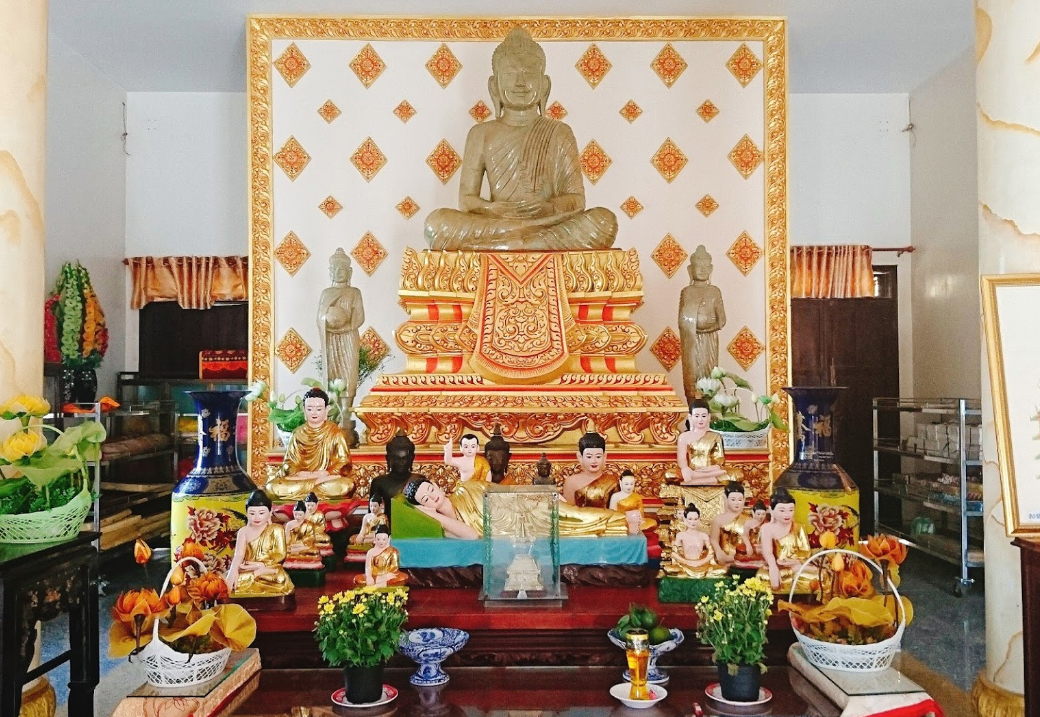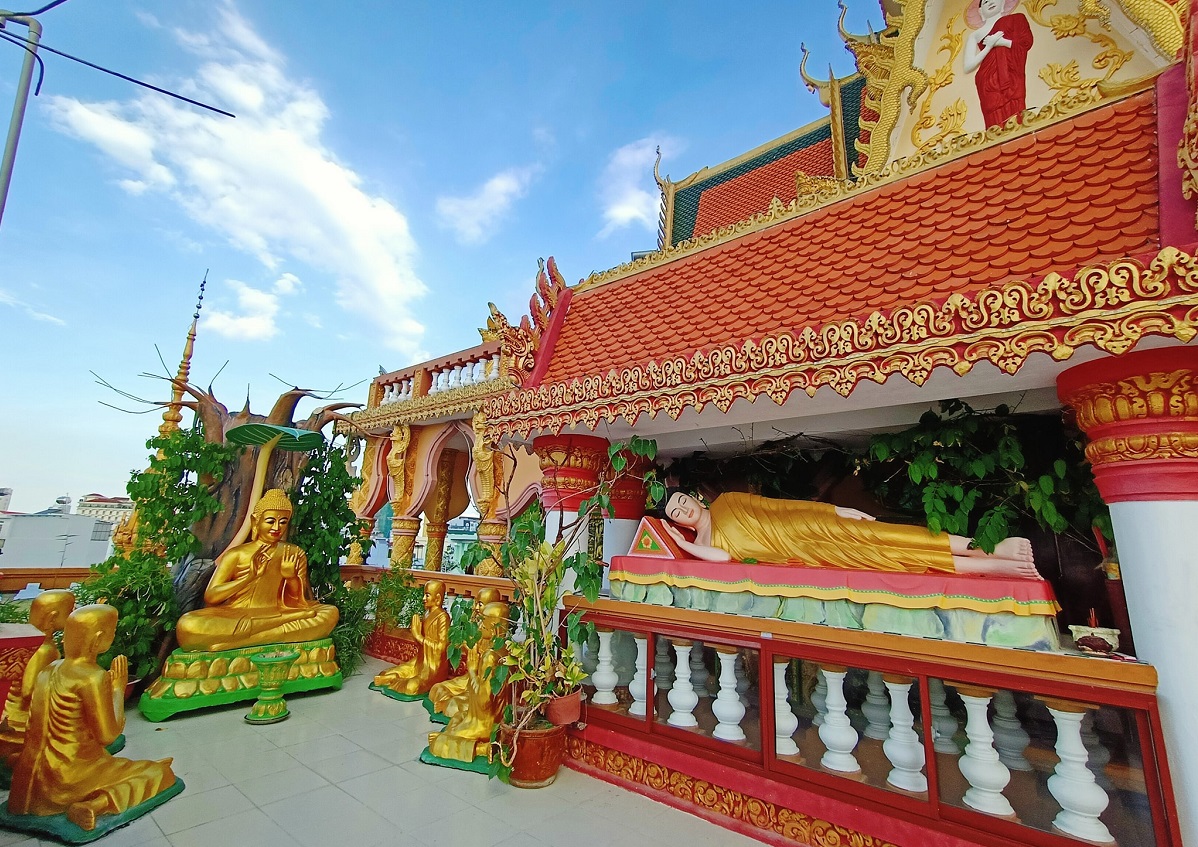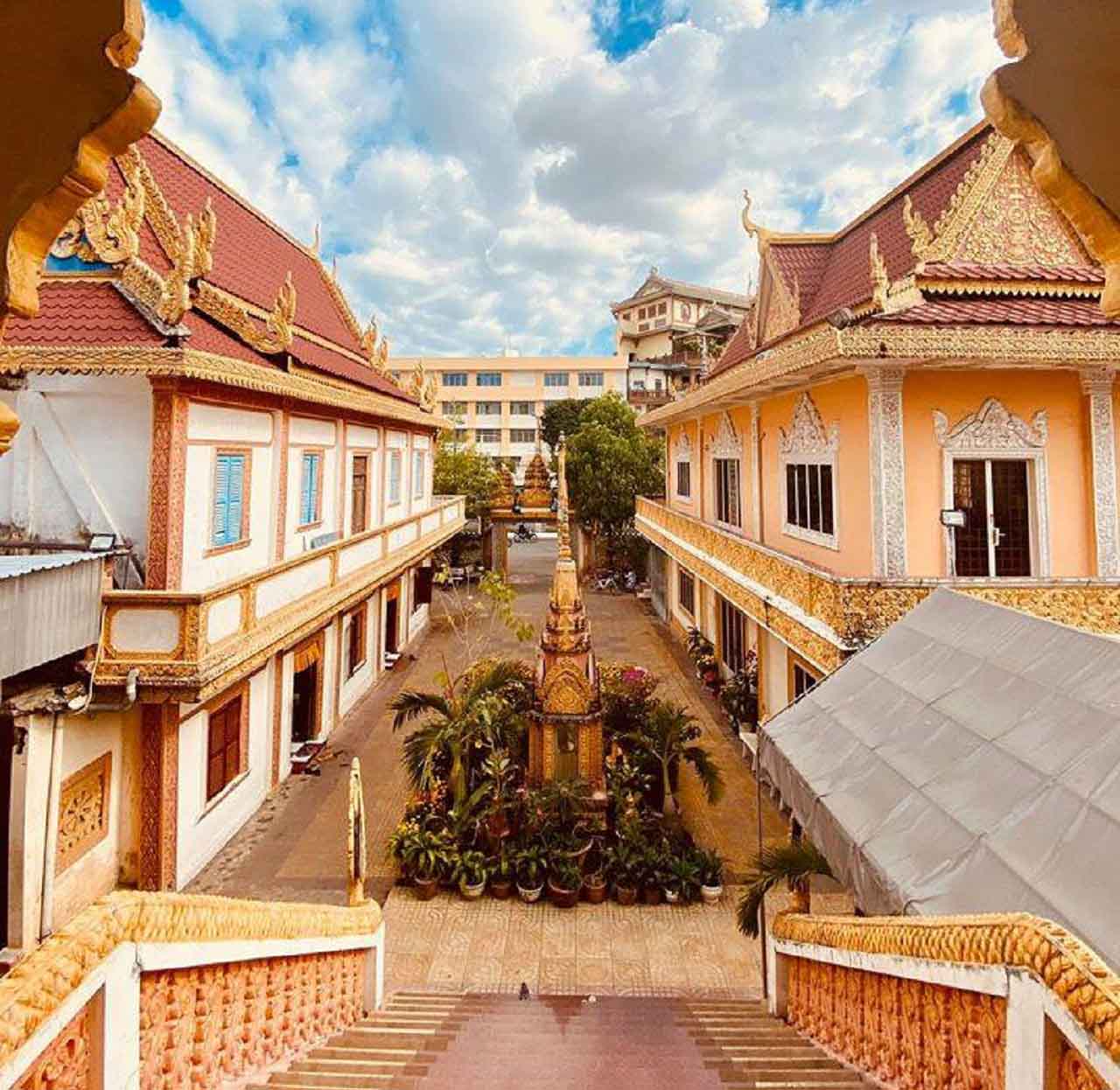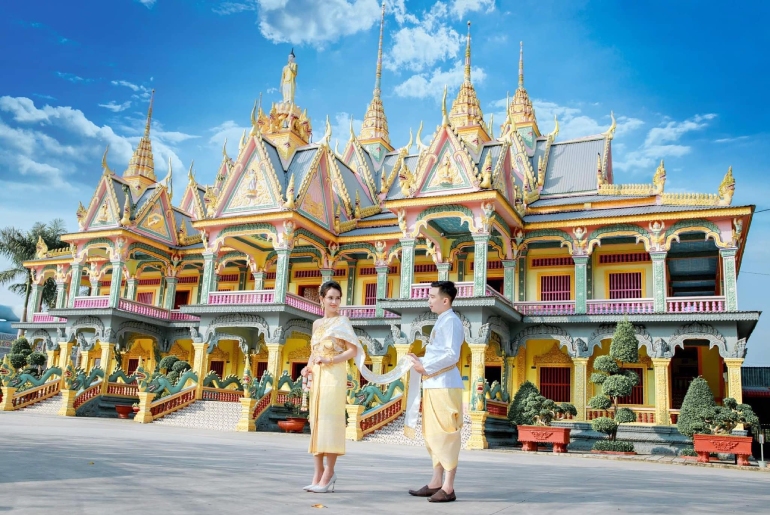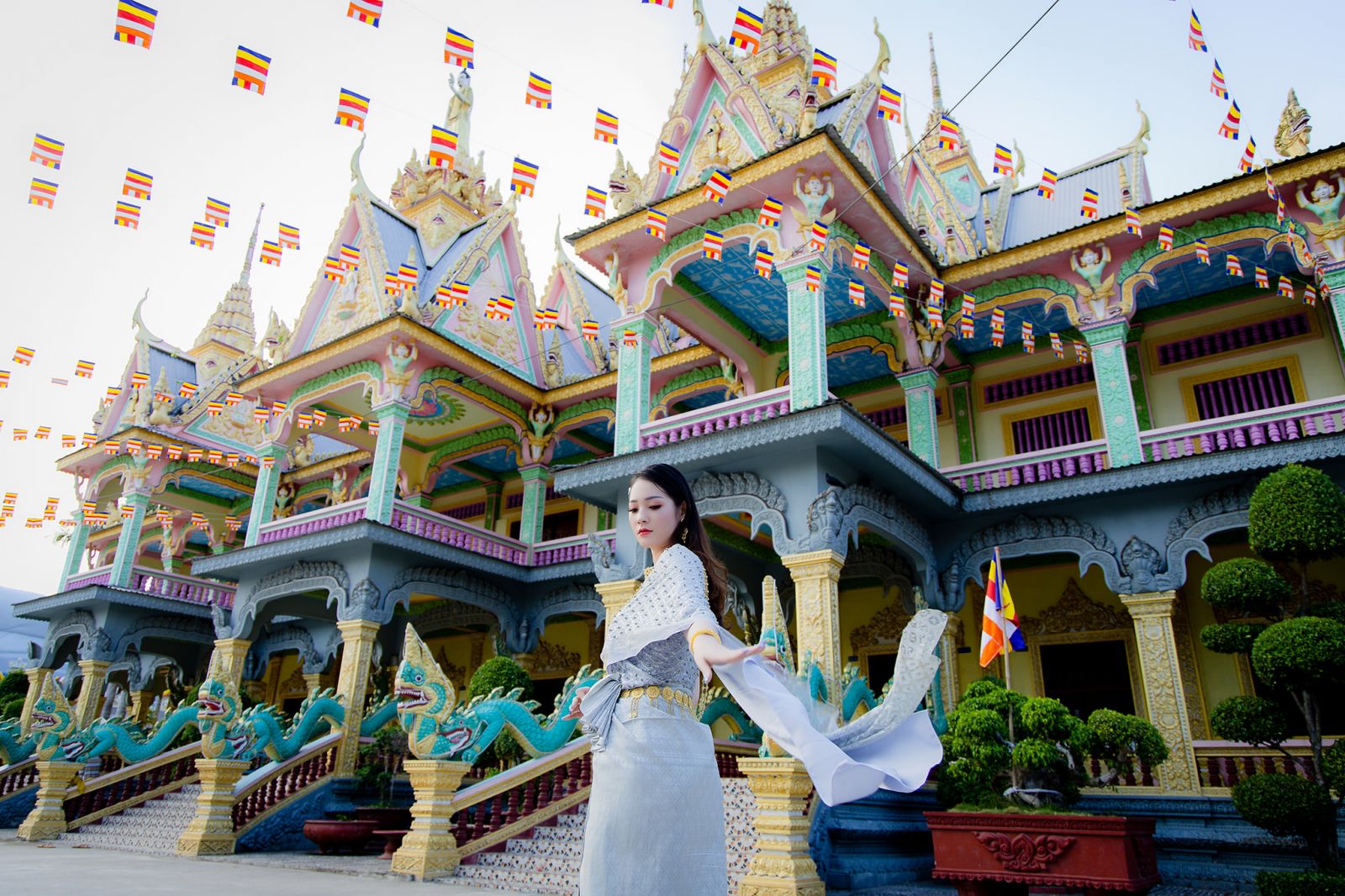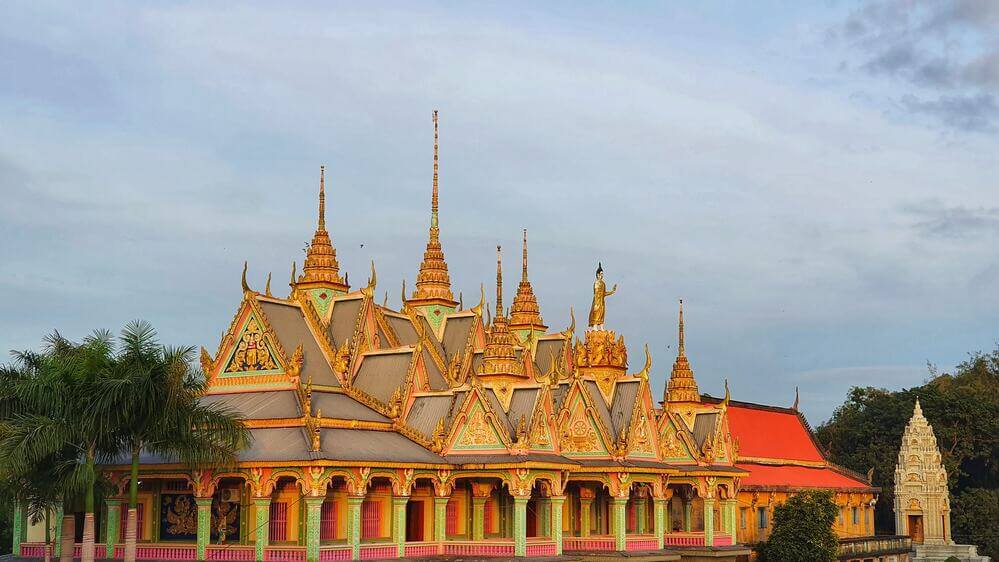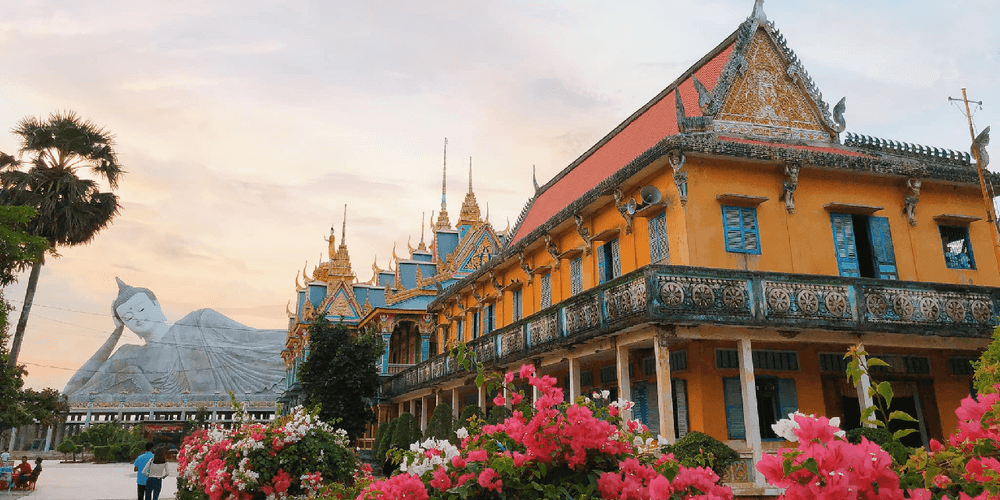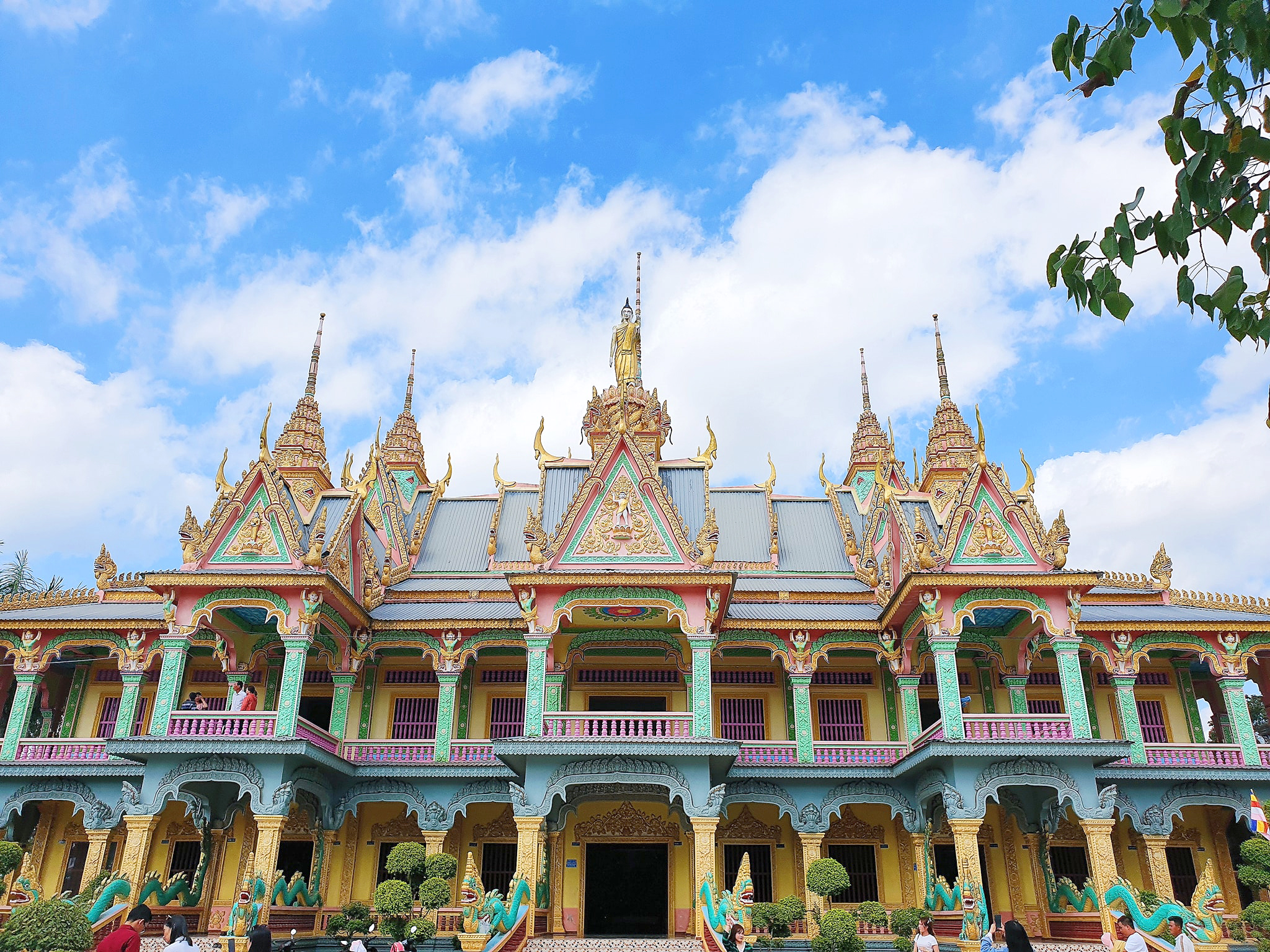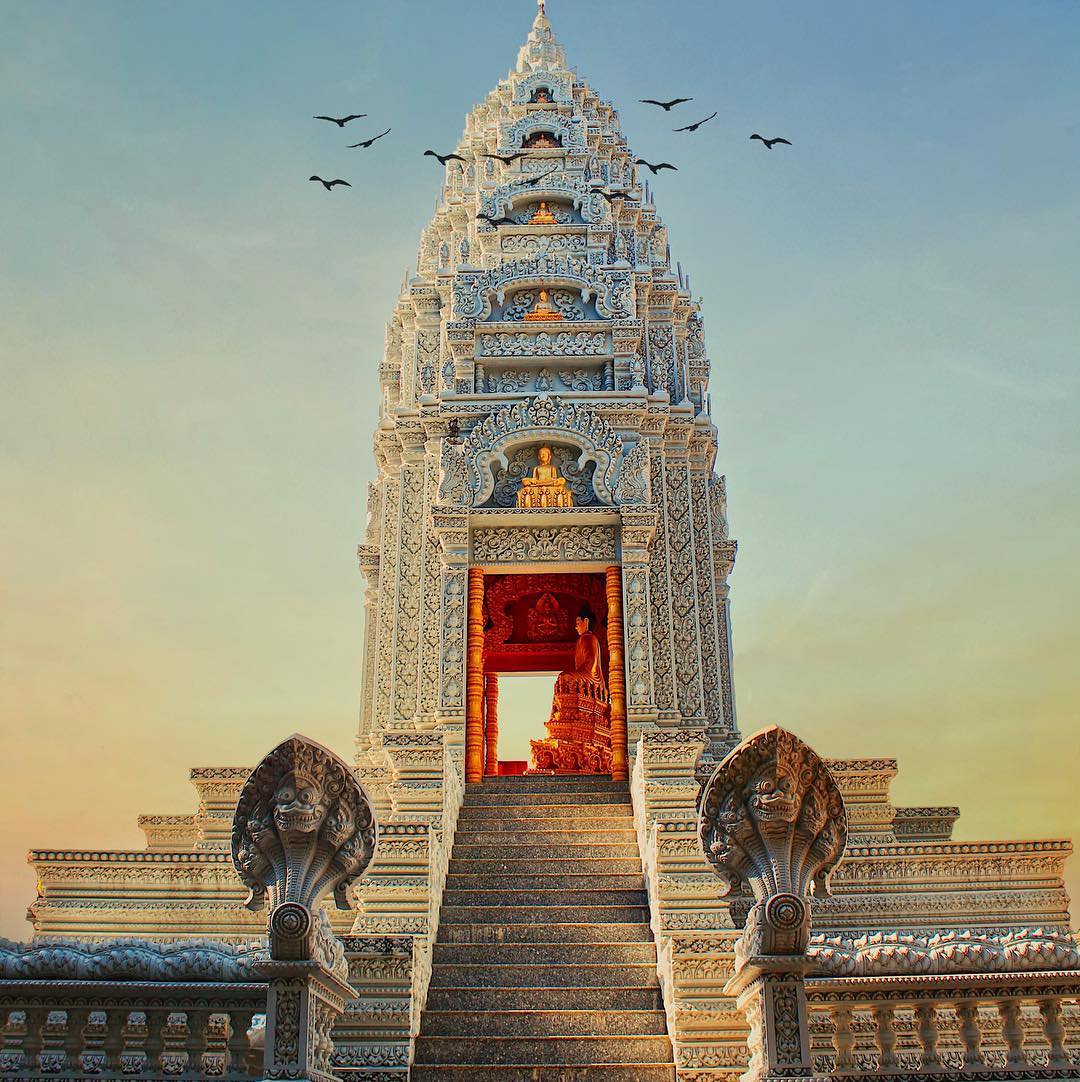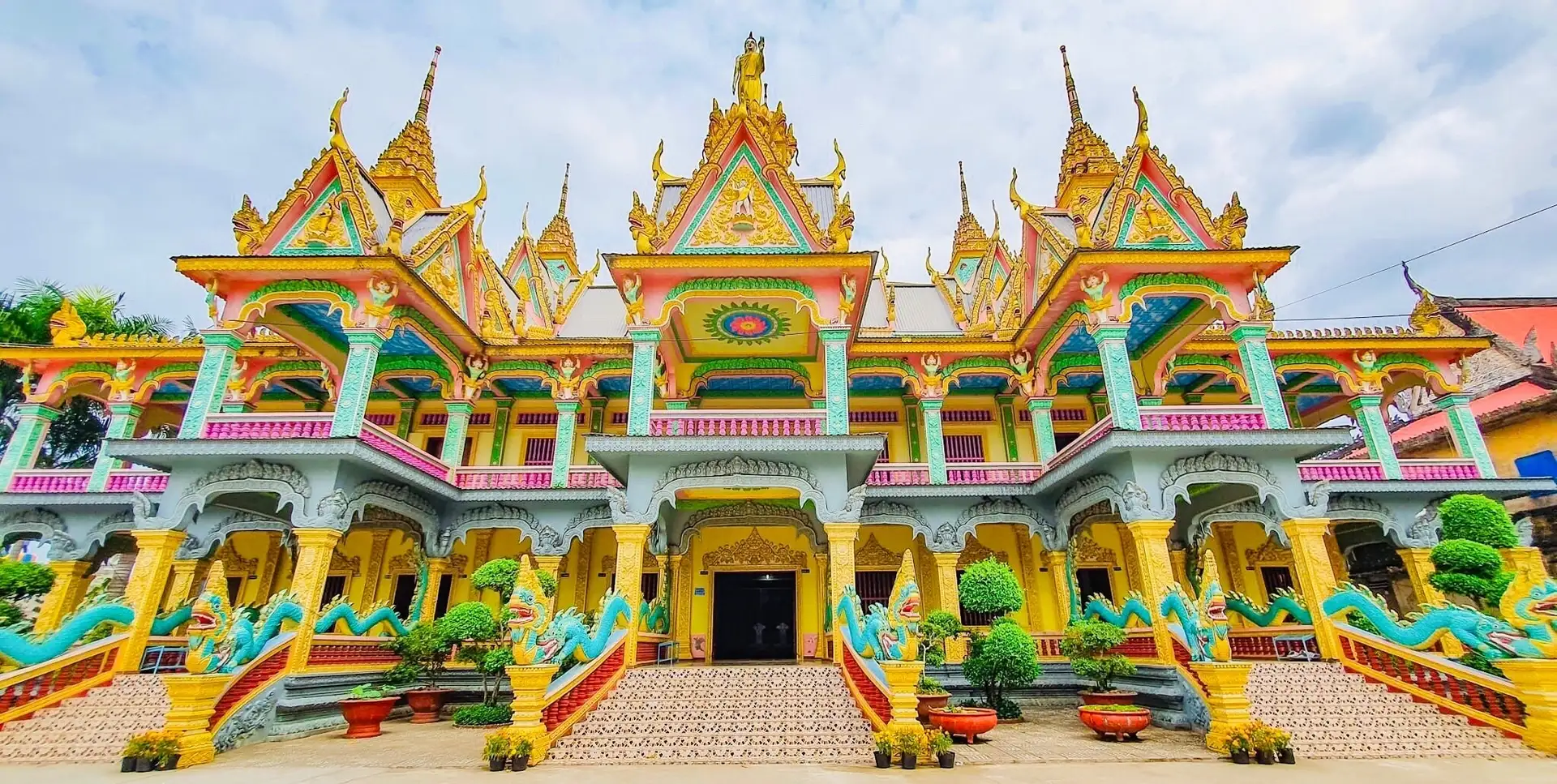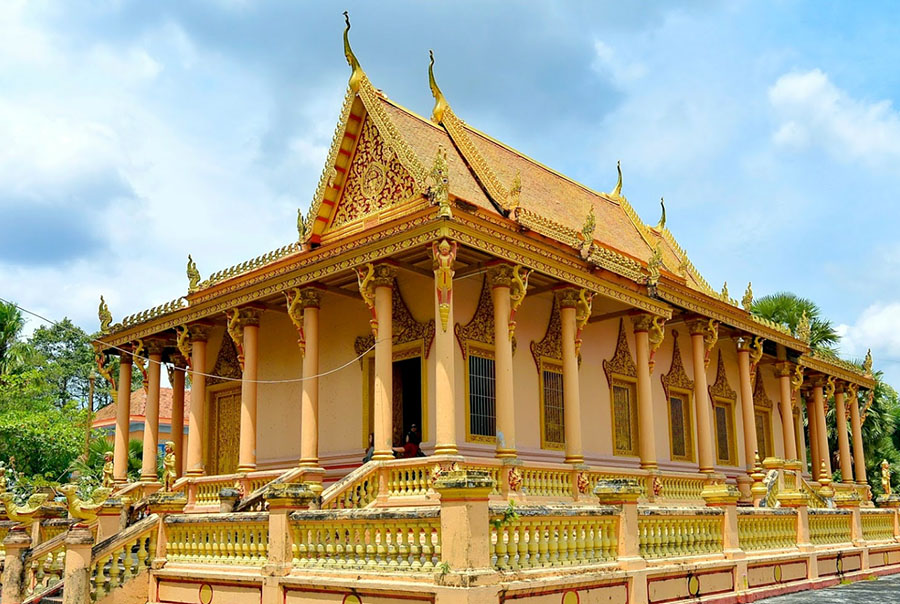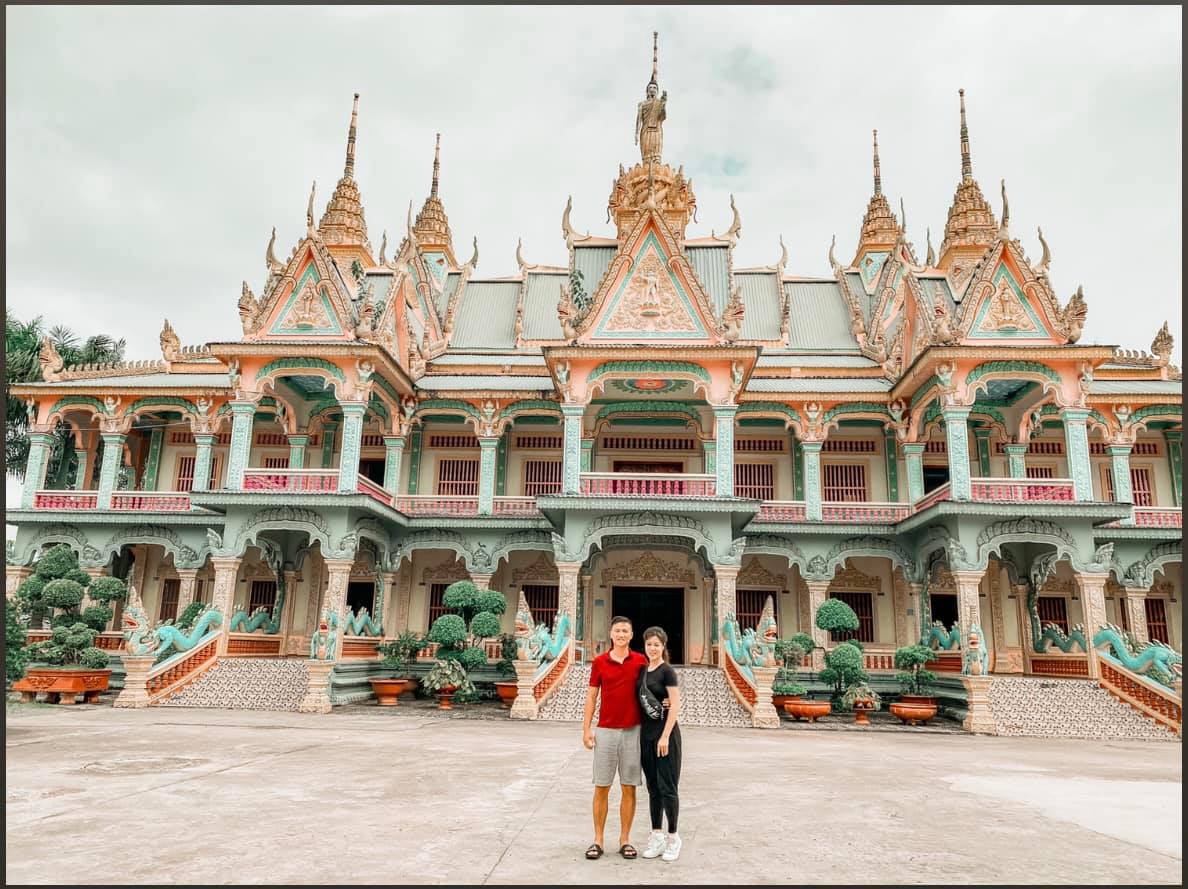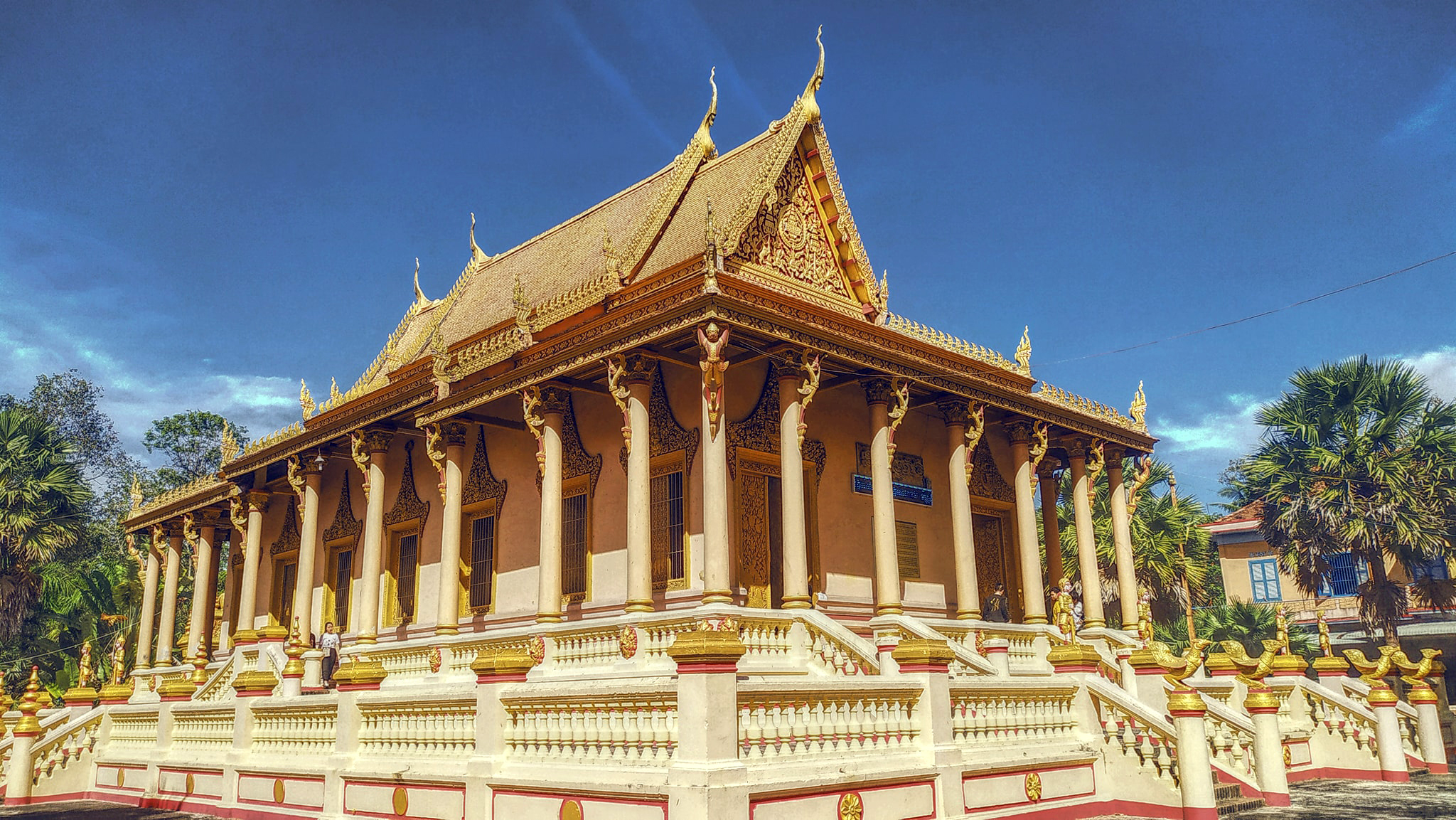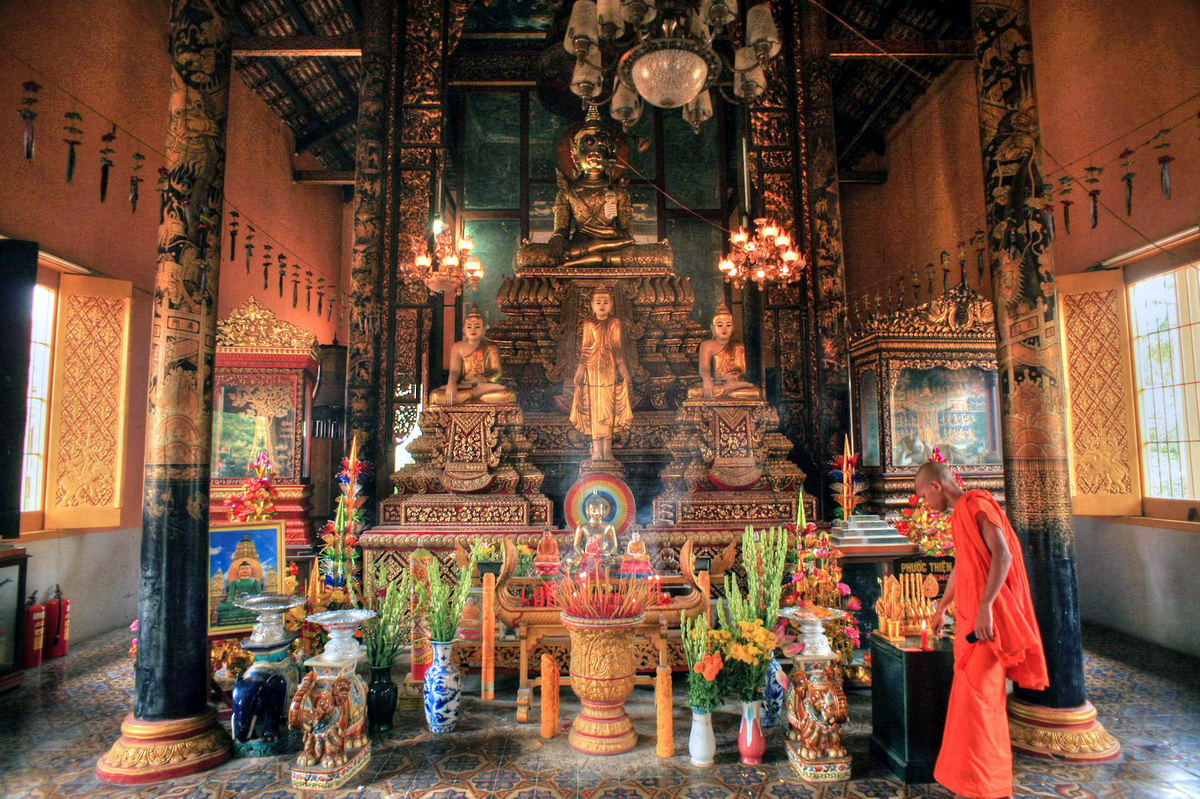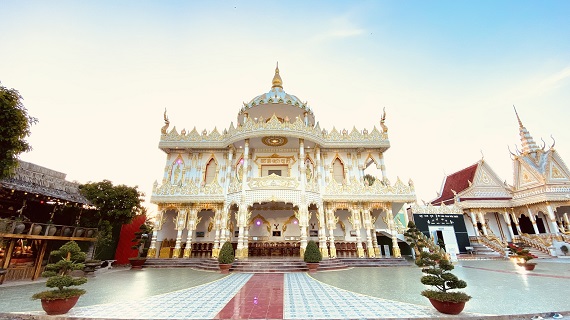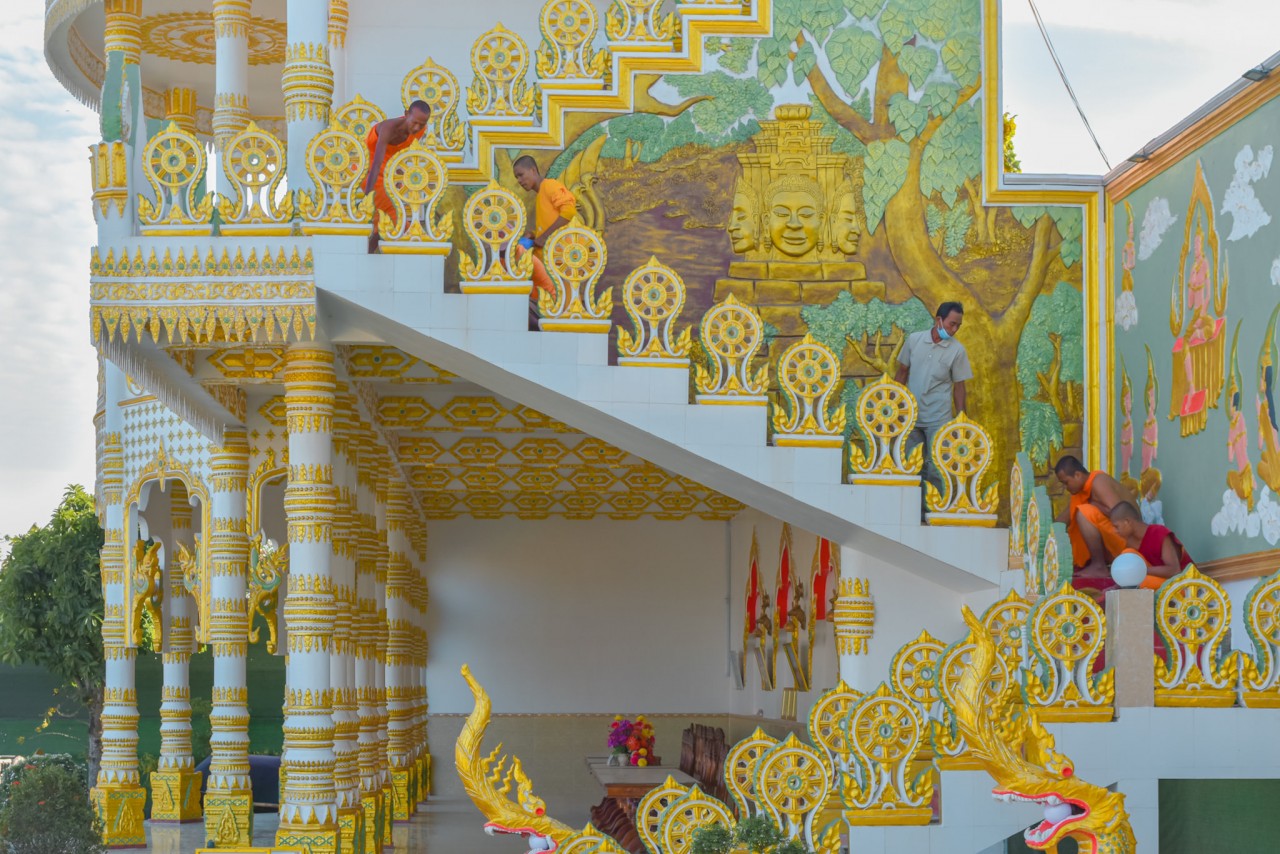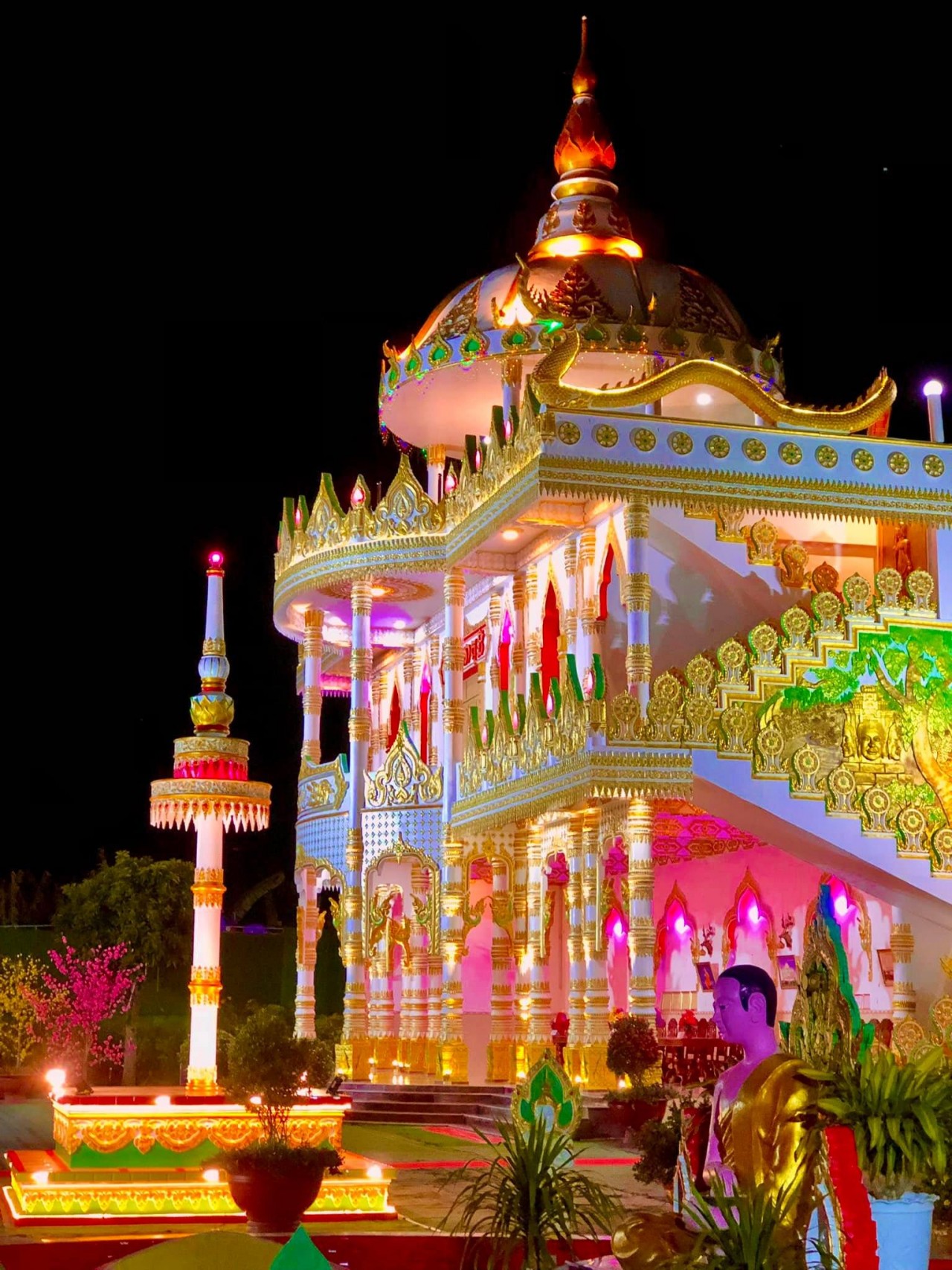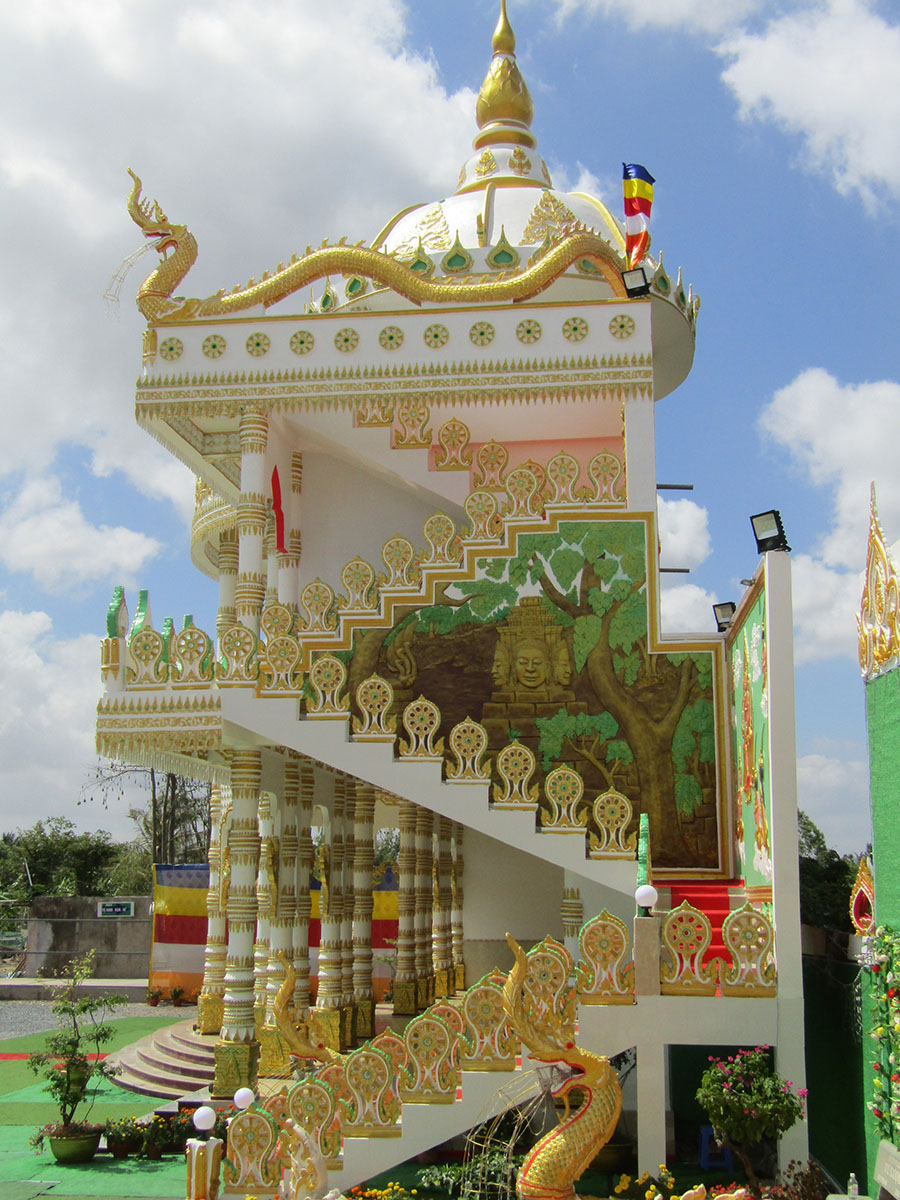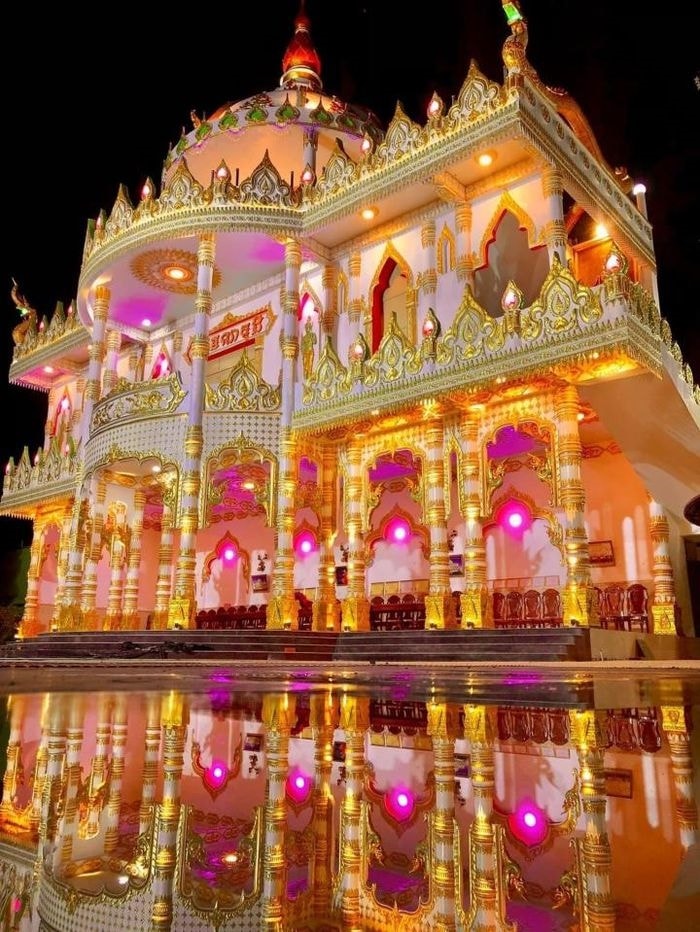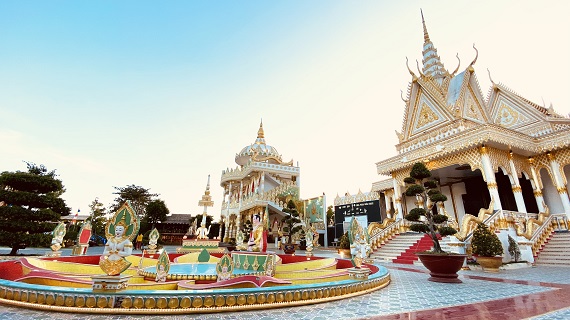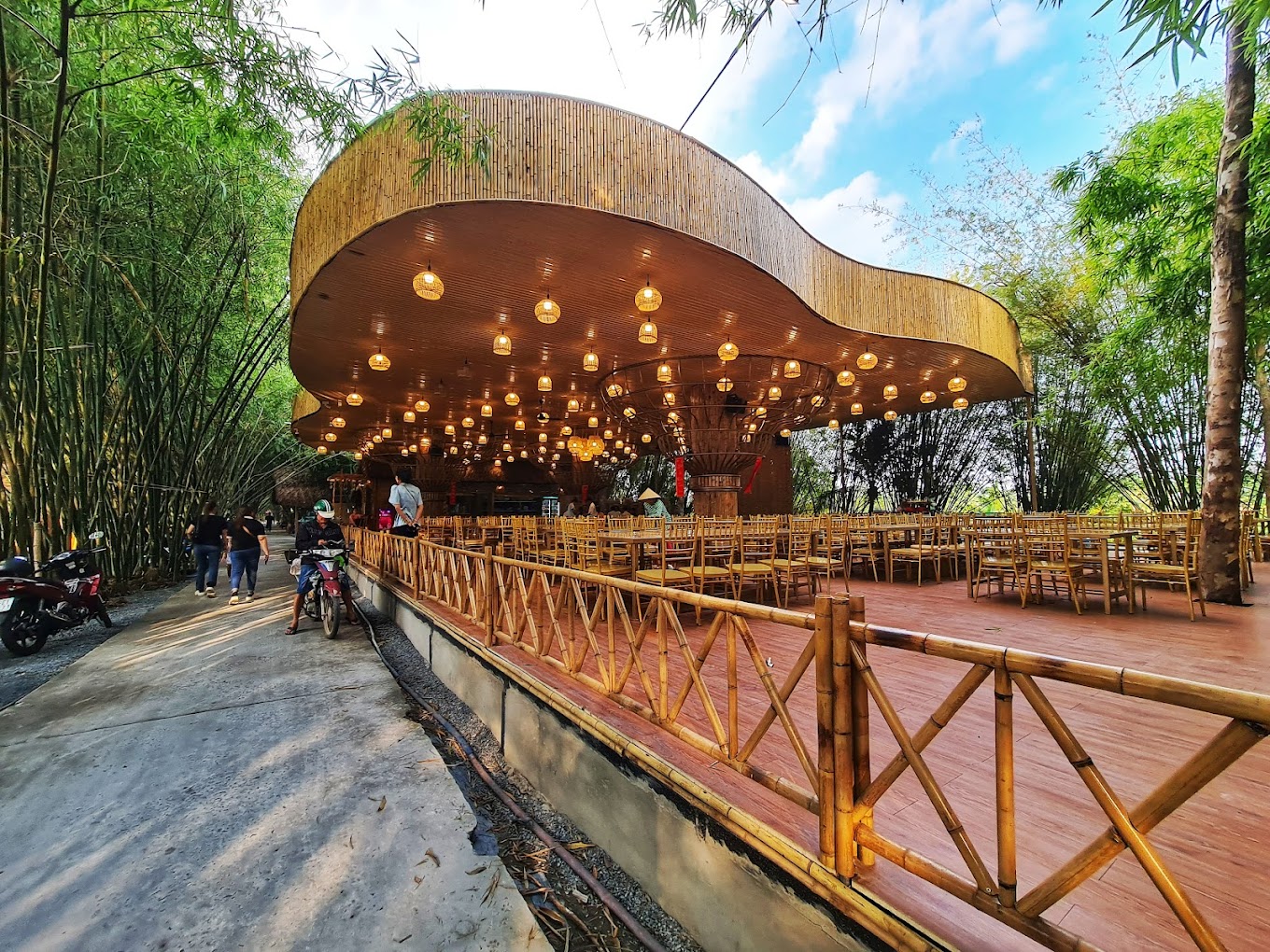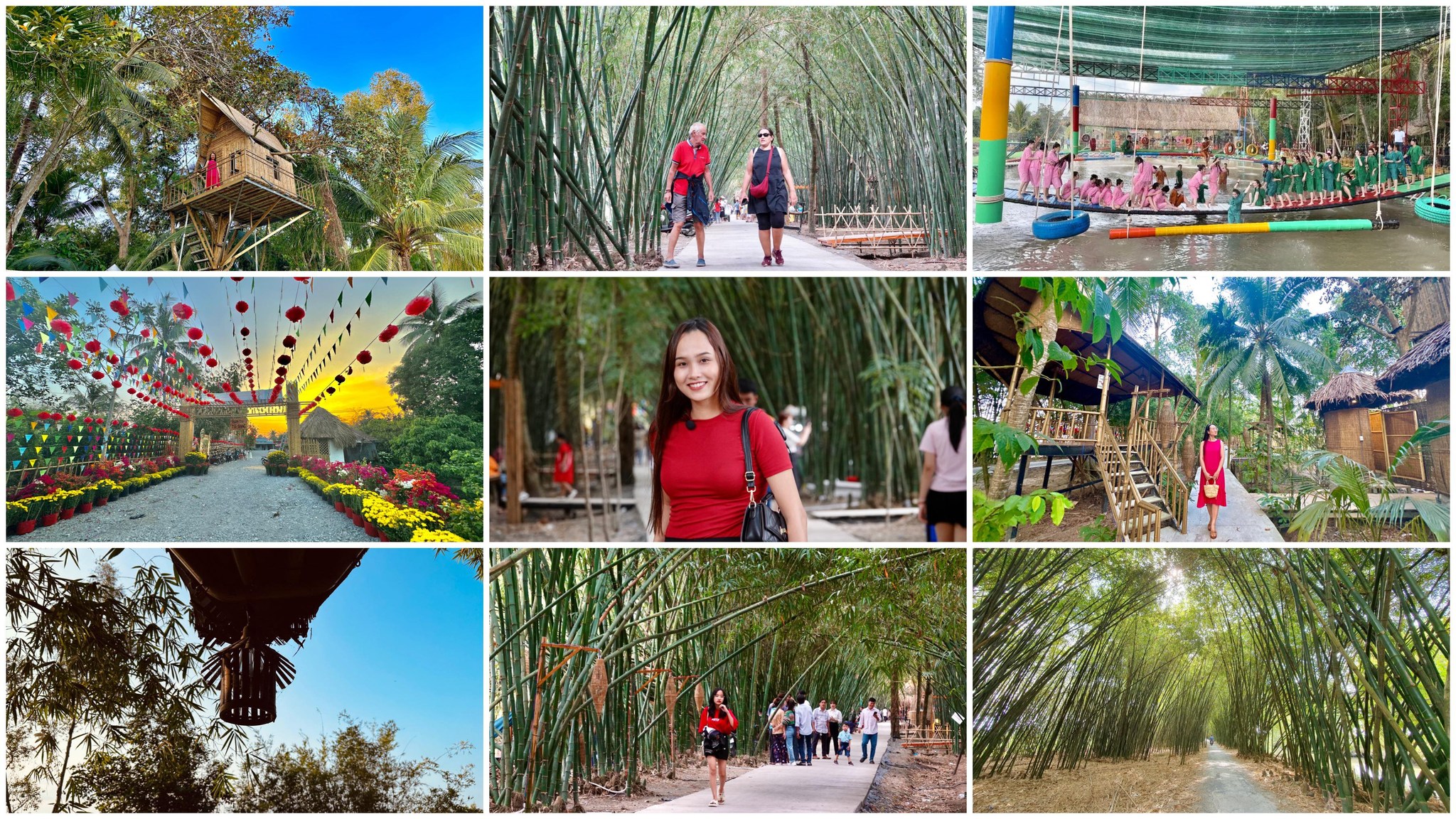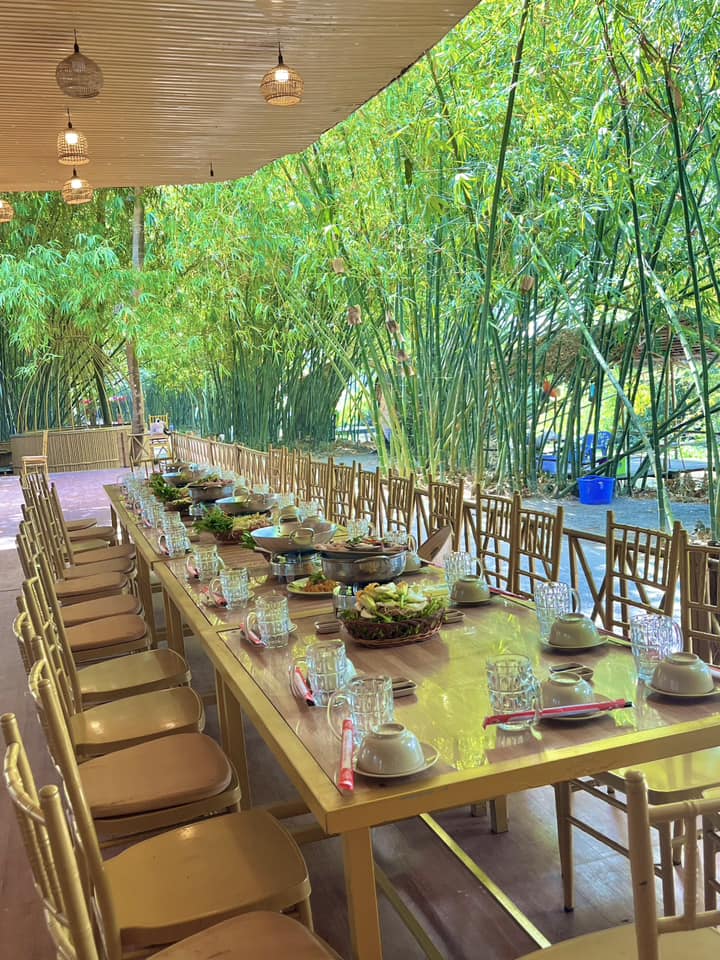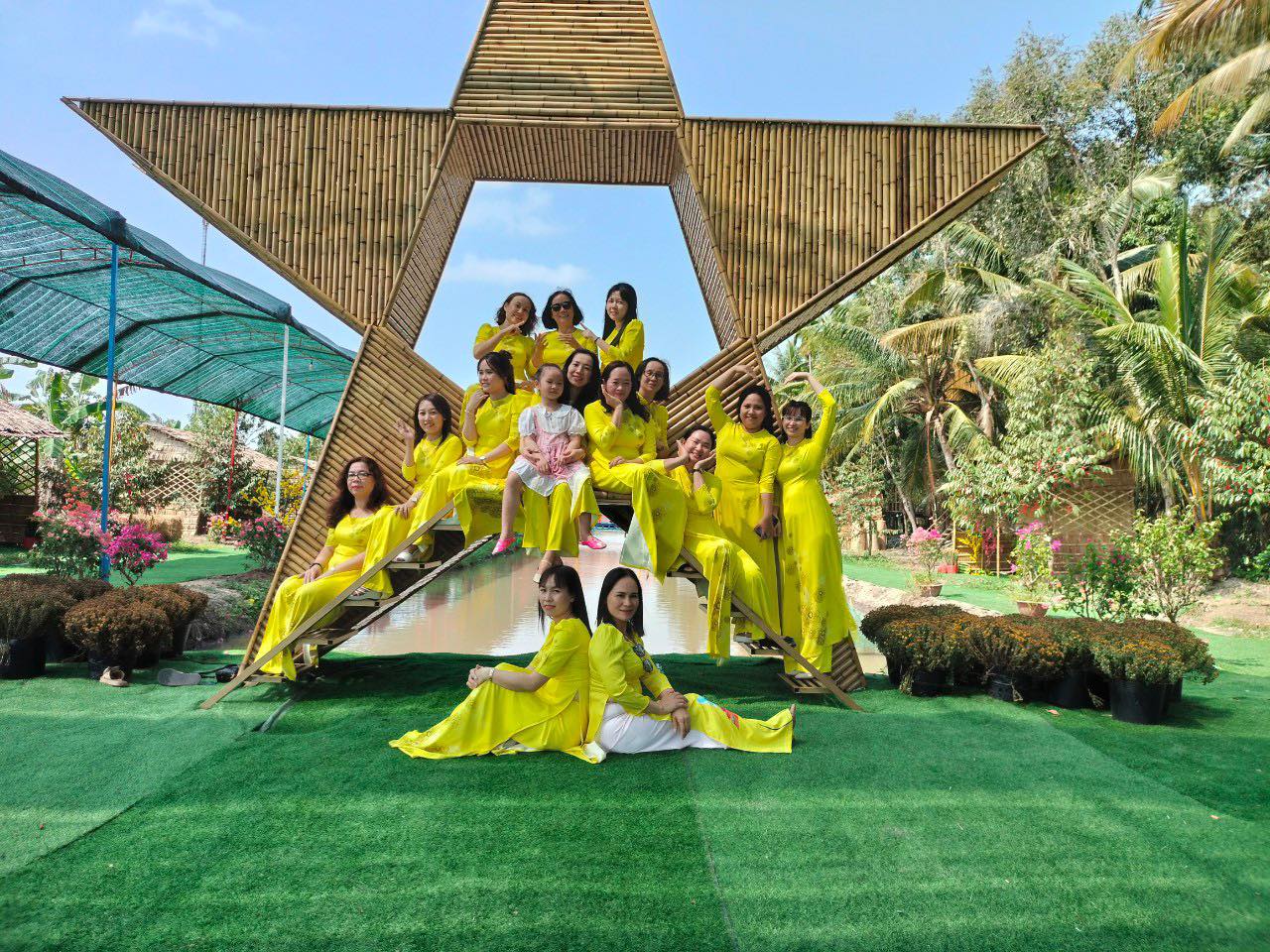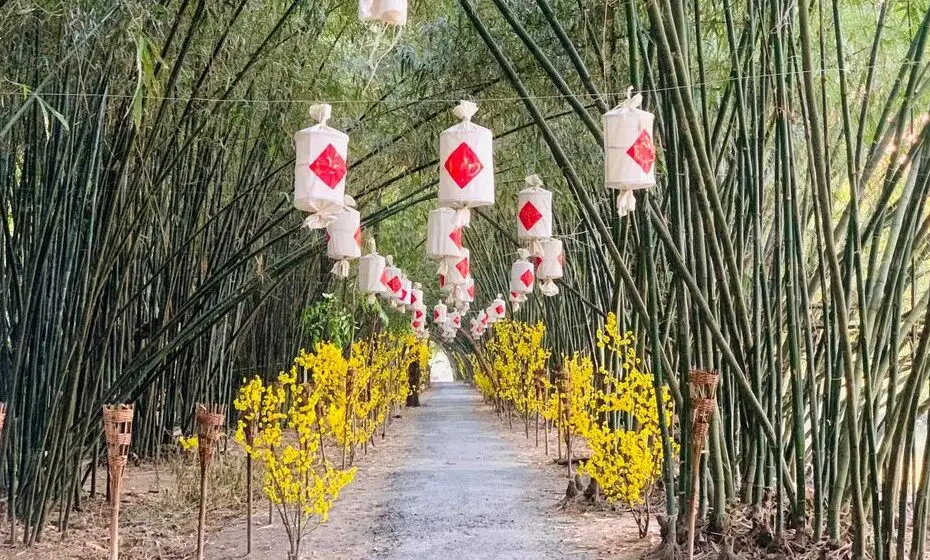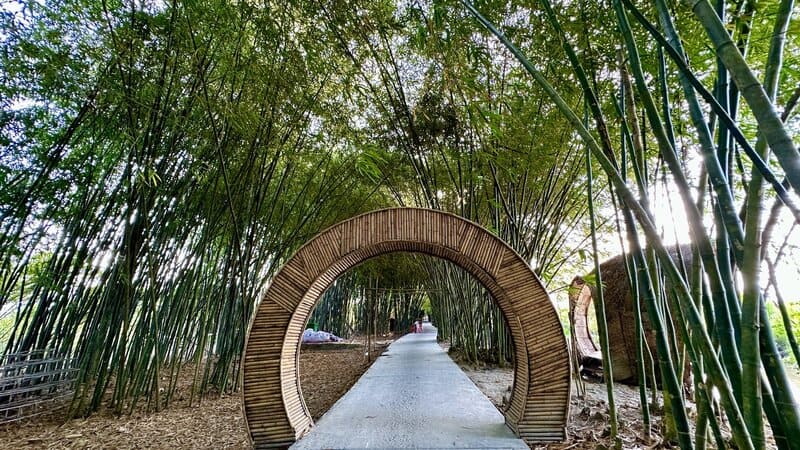Tourist destination
Na Hang tourist area
Ho beach is located in Vinh Hai commune, Vinh Chau town, 20km from Vinh Chau town and about 45km from Soc Trang city. Beach Lake has a relatively convenient traffic position because it is located next to the Southern Highway River Hau (Highway 91B), which helps visitors can move easily from Can Tho city, Bac Lieu province or by provincial road 934 , 935 if traveling from Soc Trang city. In addition, in the future, the key transport works of the province such as Chau Doc - Can Tho - Soc Trang and Dai Ngai highway will create conditions to attract inter -regional tourists to the tank lake. The beach of the lake is naturally blessed with pristine, rustic beauty with smooth sand and murmuring waves beside the immense, blue protective forest. The tank lake has been formed due to the invasion of seawater for many years. There is a concave land that looks like a large lake that is slowly accrued along the water up and down to the tide. Along 72km of coastline of Soc Trang province, there is rare place as beautiful as a tank lake because most of the coastline is black sand, mud beach or alluvial mud due to the estuaries of Hau River. Due to the influence of Hau river alluvium, the beach water of the tank also has a relatively clear differentiation. In the rainy season, the Hau River has a large amount of alluvial from the upstream that will cause the sea lake to be slightly tinted with alluvium, whereas in the dry season, the beach will be clearer and green. Coming to Lake, visitors will be immersed in the pristine, rustic natural scenery with smooth long sand, enjoying each cool sea breeze. Visitors can participate such as walking along the beach, participating in sports games, camping ...; In particular, this place is very suitable for organizing outdoor picnics, "team building" activities for agencies, units, businesses and schools. In addition, Beach Beach also has many species of seafood such as crabs, blood cockles, clams, ... visitors can enjoy at the shops right next to the beach at affordable prices. Moreover, Ho Bu beach is quite close to other famous tourist attractions in Vinh Chau town such as Quan Yin Pagoda, the ancient house Wind, coastal protection forests, agricultural areas specializing in purple onion, garlic with clean production technology ... so it is very convenient in promoting tourism development, tour development, tourism routes in town Commune or inter -district routes to diversify tourism products, retain tourists longer to promote accommodation, food and shopping services. In addition, an important factor in tourism exploitation and development is that Vinh Chau town has a long -standing community and cultural interference of the three Kinh, Hoa and Khmer ethnic groups with various types of culture and turmeric. Special techniques. The friendliness and hospitality of the local people is also a highlight in tourism development at the lake in particular and Vinh Chau town in general.
Can Tho
From November to April
2612 view
Na Hang tourist area
If you go from Vi Thanh city (Hau Giang) to Can Tho along the old Highway 61 through the switch, to Vinh Tuong junction, Binh Tan area, Vinh Tuong ward, Long My town, Hau Giang province, you will look at Seeing a very large -scale religious architectural work cluster that is Truc Lam Hau Giang Zen Monastery. With a favorable location, it is very convenient for visiting the religious activities of the people in the province and the tourist tourist tourist in Hau Giang to visit the worship. Truc Lam Hau Giang Zen Monastery is the place to cultivate the Zen Zen Zen Truc Lam Yen Tu with a line of Zen with a cultural identity of the Vietnamese national culture opened and developed by King Tran Nhan Tong. He was the third king of the Tran dynasty, after leading the national spirit against the Yuan Mong army, the peaceful country, he gave his son back to his son and went to Yen Tu to be ordained. After the enlightenment, Mr. Dung combined three previous Zen Zen and founded Truc Lam Zen. Truc Lam Hau Giang Zen Monastery is completed with important significance in preserving and promoting the traditional values of Buddhist culture, connecting the historical and traditional cultural relics of the locality, and the point Press the spiritual cultural tourism of Hau Giang Hien. The physique of the monastery built according to the architecture of Buddhist art in the Ly dynasty and the ceiling on an area of 40,000 m2. Including items: main hall, ancestor, bell floor, empty floor, Tam Quan gate, motel, statue of Quan Yin Lo Thien, Temple worshiping Au Co's mother, lecture hall, boys, abbot, house Guests, libraries, monks, nuns ... walking in the campus of the monastery, visitors will feel the spacious, airy and dignified space with the color of bricks and tiles brightly. From the main gate, walking inside and encountered the first image that was a wide pond, inside there was lotus planting with lotuses racing to show off brilliantly, enhancing the pure beauty of the monastery. At the same time help you have the most beautiful and unique photos. When you go inside the main hall, visitors will be very impressed with the calmness and solemnity here. Red brick floor, all wooden pillars are solemnly placed on the gray stone sheets of the cloud, carved with stylized lotus. With the architecture of traditional Vietnamese dynasties, Truc Lam Zen Monastery gives people a very peaceful and peaceful feeling of meditation. This has made many footsteps of the cross travelers admired when coming here.
Can Tho
From November to April
2516 view
Na Hang tourist area
Bau Vi Thuy village is considered to be the remaining leaf betel nut village in the Mekong Delta. Bau Bau Thuy village belongs to Vi Thuy commune, Vi Thuy district, Hau Giang province, this profession has been long -standing with the people and becomes a characteristic when it comes to Vi Thuy commune. At present, Vi Thuy district has nearly 40 hectares of betel nut, of which Vi Thuy commune is considered a "betel nut kingdom" concentrated nearly 200 betel gardens with an area of about 32 hectares. Only the freshwater area along this Hau river planted betel nut, eat delicious, lips, blushing. Having the opportunity to travel to Hau Giang, everyone is impressed by the betel nut garden with hundreds, thousands of betel nuts straight, green leaves fluttering a little shiny yellow looks beautiful. Betel nut is yellow betel nut, spicy flavor that many people prefer. After 3-4 months of breeding, betel nut will start leaving the leaves, every half a month picked. Typically, traders come to the home to buy betel nut to transport to customers in the Western provinces. In order to have a betel nut (40 leaves), growers must go through many stages: buying seed cuts, choosing trees as venom, opening ditch, rooting, watering, picking betel and folding into a tiles called betel nut. Arranging betel leaves into dozens (dozens sometimes 10, sometimes 16 or 20 ... depending on the place), then arranged in hundred and then Thanh Thien before handing to traders. Betel growers say betel nut must be made of cajuput trees, because the cajuput is very firmly clinging to the trunk to create conditions for betel roots to stick and grow well. People often harvest betel nut in the early morning. When you come to the pick, betel nuts will choose glossy betel leaves, just ripe to golden, the remaining leaves will pick the next batch the previous period about 10 days. Growers also have to make platforms to pick up leaves. When the tops go beyond the truss, cut off…. Betel nut is both a traditional culture and serving the needs of many people in daily life and during the holidays, weddings ... In addition to eating, using ants on holidays, betel is also a kind of type Pharmaceuticals are studied essential oil extract applied in pharmaceutical production and cosmetics. Recently, betel nut has also been exported to some Asian countries, bringing significant profits to betel growers. Today, very few people eat betel nut, so the image of areca tree and betel nut has gradually faded. But in Bau Vi Thuy village, there are still yellow and cool betel nut gardens that make the guests passionate.
Can Tho
From December to April
2633 view
Na Hang tourist area
Wonderland Can Tho tourist area is located in My Ai hamlet, My Khanh commune, Phong Dien and has entrance from Truc Lam Phuong Nam Zen Monastery. Its position is located right in front of the monastery with a distance of 500m. This tourist area is designed and built unique, bringing new experiences for visitors.With the ideal position, Wonderland Can Tho not only attracts visitors by the natural beauty but also by the bright space. Create, colorful. Coming here, visitors will enter a world of imagination, where unique and creative models are made up of thousands of fresh flower pots. Discovering Wonderland Can Tho, visitors will be immersed in a large space with unique decorative models from rich flowers. From the cultural and architectural models to the art statues, each viewing angle brings a new and interesting feeling. Not only is the ideal destination for commemorative photos, Wonderland tourist area is also an ideal place to relax and enjoy the fresh air of the peaceful countryside. This will be an unforgettable experience in the journey to discover the beauty of Can Tho and the West of Vietnam. With a large area of 5,000m2, Wonderland Can Tho tourist area is like a fairy forest with more than 100 models of colorful and diverse decorations. The highlight of the tourist area is the dragon statue named Thien Hai Binh An with the size: 16m long, 5m high and weighing nearly 3 tons, creating an ideal check-in point for the Spring of Giap Thin. At Wonderland Can Tho, visitors will be immersed in a fertile flower world. From shallow coconut flowers, ten -hour flowers, fake flowers, apricot blossoms to cherry blossoms, peony, sunflowers and many other flowers, tens of thousands of flower pots are mobilized to create a unique space and charming. At this point, you will discover the sophistication and elegance of the classic European architecture decorated with fresh flowers along with impressive artworks such as Kingkong, dinosaurs, bears and peacocks, creating those. The picture is shimmering and beautiful. Besides, visitors can also relax and enjoy the fresh air of the countryside by watching the windmills and chill pillars decorated with fresh flowers or enjoying delicious food in the field coffee area. garden. Wonderland Can Tho will definitely be an ideal destination for relaxing and unique experience. Fishing in the middle of nature: Relax with the peaceful fishing experience, immersed in nature and enjoy the relaxing moments with family and friends. Children's play area: With children's play area, children will have fun and rewarding moments, while parents can relax and enjoy the peaceful space of Wonderland Can Tho tourist resort. .
Can Tho
From November to April
2335 view
Na Hang tourist area
Luu Huu Phuoc Can Tho Park - one of the largest parks in the city center was taken at the name of the famous musician of the homeland "White rice in the clear water" is the celebrity Luu Huu Phuoc. With a unique design of a guitar, the park is considered the green heart of Can Tho city. Luu Huu Phuoc Can Tho Park is located at Hoa Binh Boulevard, Ninh Kieu District, Can Tho City. Built in early 2015 with an area of more than 2 hectares, the park has a design with a large image and is considered as a green lung, maintaining fresh air as well as creating a fun spot for people. Can Tho Street. Large area and modern stage design with more than 7000 seats, Luu Huu Phuoc Can Tho Park is fully installed with exercise equipment, sports and amusement parks for children. Along with the clean and modern public toilet system, this place brings many interesting experiences, promising to be an ideal destination in your journey to explore Can Tho. The park is also focused on planting a lot of green trees and often caring for small landscapes such as flower garden, lawn, forming an attractive destination for locals and tourists. In the morning in Can Tho, you can choose to come here to jog, breathe fresh air and exercise exercise to improve health. In the evening, at the park there are many fun activities for young people such as roller skating, skateboarding ... and street food dishes sold around will be an interesting experience for the cross. Focusing on planting a lot of green trees and often taking care of small landscapes such as flower garden, grass, forming an attractive destination for locals and tourists. In the morning in Can Tho, you can choose to come here to jog, breathe fresh air and exercise exercise to improve health. Every year, Luu Huu Phuoc Can Tho Park welcomes a lot of tourists to visit. Hopefully, with all the details of the central park of Can Tho city will help you and your family have many interesting experiences when coming to this land.
Can Tho
From November to April
2414 view
Na Hang tourist area
Can Tho has a large number of Khmer people living. That's why this place is famous for Khmer temples with unique architecture. Among them is Munir Ansay Pagoda - the most beautiful and sacred Khmer pagoda in Can Tho. Munir Ansay Pagoda (also known as Munirensay) is located at 36 Hoa Binh Avenue, Tan An, Ninh Kieu District, Can Tho City. The pagoda was started to be built in 1948 with only simple bamboo. 6 years later, the temple gate began to be built according to the famous Angkovat architecture. In 1964, the Main Hall began to be built. It took 40 years, until 1988, for Munirensay Pagoda to be officially completed after many rounds of restoration and construction. Munir Ansay Temple also has very outstanding architecture. The pagoda was built based on the unique architecture of the legendary Angkorvat temple. Inside the pagoda is built with main areas including: pagoda gate, main hall, reception hall, Xa Loi tower, ashes tower, monk houses and auxiliary buildings. All are decorated with elaborate, meticulous motifs with the main color tone of orange and yellow, combined with unique blue. The temple gate was built according to typical Khmer architecture. The lower part is two pillars painted blue and decorated with eye-catching golden patterns. In the middle are two iron doors also painted gold. The most impressive point is that the top is built according to the unique Tam Bao tower architecture. With the tallest tower in the middle and two lower towers located close to both sides. From a distance, this gate is especially similar to the three Angkorwat temples of Cambodia. This architecture reminds me somewhat of the pagoda gates and three-door communal house gates of Vietnam with a bit of similarity. The two sides of the temple walls are also decorated with green-yellow tones and unique sculptures. Stepping from the entrance gate, in the middle of the temple yard, you will immediately see a splendid yellow stupa decorated uniquely. Right at the foot of the tower is the statue of Shiva and surrounding trees. Behind the tower is the 2-storey main hall area, on the left is a row of monks' houses, on the right is a hall to receive guests and have meals. The main hall is the center of the entire temple, built higher than the surrounding areas. In front of the main hall is a tower containing Buddha relics and stairs leading up. The pillars and arches of the main hall are decorated with embossed reliefs and delicate carvings. Popular patterns are the images of Reahu (Tiger), Fairy, god bird Kayno, Chan Yeak... These are all sacred images in the Brahmin religious culture of the Khmer people. Munir Ansay Pagoda follows the Theravada school of Buddhism, carrying Theravada ideology. This is a typical Southern school of Buddhism, worshiping only one Buddha Shakyamuni. Inside the main hall, only Buddha statues are worshiped in many standing, lying, and sitting positions. In particular, the main worship statue is placed at the highest position, sitting solemnly on a 3-storey lotus throne. In addition to worship, the temple also organizes teaching and spreading Buddhism to people in the area. In addition, the pagoda also does a lot of volunteer work, providing free accommodation for ethnic Khmer students in particularly difficult circumstances. Munir Ansay Pagoda is the spiritual and cultural center of Tay Do region. Therefore, this place is an indispensable destination when traveling to Can Tho. Exploring Munir Ansay will help you take beautiful check-in photos and gain more knowledge about the Buddhist culture of the Khmer ethnic people here.
Can Tho
From November to April
4020 view
Na Hang tourist area
Khmer pagodas in the South are something very unique to the Mekong Delta. Every time a pagoda is built, it is the effort of many generations and people living on the land, because the pagoda is a solid fulcrum for the people of this place, a place to practice the most sacred beliefs they have. never forget. Currently, Soc Trang is a land densely populated by Khmer people with massive, elaborate Khmer pagodas and century-old Buddhist works. Among hundreds of Khmer pagodas in the city, Som Rong Pagoda is the most impressive name, most known to many tourists because this is the greatest pride of the people here. Som Rong Pagoda's full name in Khmer is Wat Pătum Wongsa Som Rong. I heard people say that the pagoda has been around for a long time. It used to be a small pagoda with a simple thatched roof that was passed down through many different generations. During the reign of Venerable Ly Duc, he rebuilt a new, more spacious pagoda on a large plot of land. In 2000, the pagoda began to rebuild the new main hall, and in 2013, the Sala assembly house was built, along with the stupa and the largest statue of Buddha entering Nirvana in Vietnam. With more than 20 years of construction, Som Rong pagoda Now the pagoda has become the most proud spiritual fulcrum of the people here. For Soc Trang tourism, this pagoda is a proud point to promote the image of Southern Khmer pagodas and the beauty of Vietnamese pagodas to the world with top-notch works. The building is located right at the entrance. The four-sided stupa, four paths up, is impressive with its gray-white color. The tower has seven floors gradually decreasing in height from large to small and the base of the tower has three floors. The center of the tower is the image of Shakyamuni Buddha sitting on a lotus. The stupa impresses visitors with its unique sculpting and shaping, each detail is very vivid with stylized lotus flowers, vines running along each edge, fire and angel patterns. In addition to being prominent in the stupa sculpture, it is also decorated with five-colored flags on major holidays. The impression outside the main hall is the brilliant decoration, curved walkways, pillars covered with classical patterns, and murals about Buddha and life. On the top of the front of the main hall is the image of Buddha's birthday walking on a lotus throne. On both sides of the main hall are two hallways, the right hallway is to look out to the stupa, look at the Sala house and the Buddha's nirvana statue. table; This is an extremely beautiful photo angle that many of you may miss. In the near future, the main hall and the temple library will also be restored. The impressive Sala Assembly Hall took more than four years to build (2013-2017) and is extremely spacious and is used to practice the traditional rituals of the temple, as a lecture hall and a monastery. The architecture of Sala Assembly Hall is also extremely impressive in the eyes of visitors because of its grandeur, scale and color. But few people know that this project is completely based on traditional architecture, combined with creating an interior space with a modern structure with many uses. The Sala Assembly House has two floors, many layers of roof, and combines many outstanding colors to create distinction. Take full advantage of all the traditional decorative arts of Khmer pagodas to adorn the Sala assembly house. Entering from the stairs is decorated with the dragon god, the first floor attic is decorated with the snake god Naga. The second floor's attic is embossed with a dancer, on each part of the attic is the god Krud, running along the edge of the tiled roof are the dragon god and bird god. Each roof fringe is pointed in the shape of Xome mountain. The statue of Shakyamuni Buddha entering nirvana at Som Rong Pagoda is the most special work of the pagoda. The statue is 63m long and 18m high and is considered the largest reclining statue in Vietnam. Thanks to this project, the pagoda is known to many tourists from near and far, attracting tourists as well as followers of professional photography who come here to hunt for moments. Som Rong Pagoda is an interesting stop on the journey to explore Soc Trang tourism with ancient, sacred pagodas and unique architecture.
Can Tho
From November to April
3298 view
Na Hang tourist area
Soc Trang, with its unique characteristics of having many ethnic groups living together, has created a diverse culture. Traveling to Soc Trang, you will encounter many ancient and magnificent pagodas and temples, all with their own unique characteristics, including KhLeang Pagoda. KhLeang Pagoda is one of the ancient Khmer pagodas in the Mekong Delta region with a history of nearly 500 years. KhLeang Pagoda bears the mark of very sophisticated and sharp Khmer architecture, but still blends Vietnamese and Chinese styles in its decoration. KhLeang Pagoda is located on Ton Duc Thang Street, Group 5, Ward 6, Soc Trang City in a large campus, shaded by ancient trees, most of which are palm trees, a tree species associated with life and culture. culture of the Khmer ethnic people. Coming here, visitors can enjoy fresh air, learn about ancient Khmer documents, legends about the origin of Soc Trang and admire the unique architecture of the pagoda. The name of KhLeang Pagoda is associated with the legend of the place Soc Trang. If translated from Khmer, it means "land with warehouses", evoking a rich ancient land. According to bibliographies, the pagoda was built in 1533, at first it was just a thatched pagoda, but after many restorations, it was built with bricks and tiles. The current temple architecture such as the main hall and Sala were newly built in 1918. The temple has an architecture similar to Theravada Buddhist temples in Thailand and Cambodia. Khleang Pagoda's architectural complex includes: main hall, sala, monk's house, hall,... arranged harmoniously on high ground. An equally unique point is that most of these works in Khleang Pagoda are built in the traditional stilt house style of the ancient Khmer people of the South, each work is sculpted, carved with patterns and motifs. Sophisticated with bold features of ancient Khmer architecture. The main hall is located in the center and is divided into three steps, each about 1 meter high and surrounded by a brightly colored fence. The outer fence is large and then gradually smaller inside, the distance between the fences is very wide, the temple floor occupies a very large area. The edge of the roof has a winding dragon statue with a fan-shaped head and curved tail. Inside the main hall, there are wooden pillars, very large, smooth black, covered in gold with images about the Buddha's life and Buddhist activities. The ceiling and surroundings are decorated with many drawings of Buddha images, demonstrating the harmony between architecture and painting. The main hall has a 6.8 m high Buddha statue, the 2.7 m high body of the statue was cast in 1916. The statue is placed on a splendid lotus throne with an electric halo that sometimes hides and appears, creating a magical atmosphere. majestic, elegant and magical. Compared to many other Khmer pagodas in the province, Khleang Pagoda still retains the unique features of ancient Khmer architecture, which are very valuable in terms of art and aesthetics. Not only that, in addition to the main features of Khmer architectural patterns, the main hall also intertwines a number of images and decorative patterns of the Kinh people on the hammock door and of the Chinese on the pillars. Carp, dragon and Chinese characters are painted on the pillars. This reflects the cultural interference in the fields of decoration and art between three ethnic groups that have long lived in Soc Trang. What is interesting is the bookcase displayed in the main hall. If we look closely, we will see leaves with ancient Khmer characters on them. These are the contents of Buddhist scriptures written on leaves, carefully preserved by the temple. With symmetrical and harmonious architectural lines, associated with unique and diverse works of art, the main hall of KhLeang Pagoda is truly a work of special artistic value. With great historical and architectural values, on April 27, 1990, Khleang Pagoda was ranked by the Ministry of Culture, Information and Sports (now the Ministry of Culture, Sports and Tourism) as a national historical and cultural relic. , belongs to the type of architectural and artistic monument. This is an interesting Soc Trang tourist destination that you should not miss if you have the opportunity to visit this land. In addition to the function of serving religious needs, Khleang Pagoda is also a place to meet the traditional living needs of the Khmer ethnic people through annual festivals and other cultural activities. Many traditional rituals are solemnly held at the pagoda, including Chol Chnam Thmay (New Year's Ceremony), Sene Dol Ta (Grandparents' Worshiping Ceremony), Ooc - Om - Boc (Moon Worshiping Ceremony),...
Can Tho
From November to April
3305 view
Na Hang tourist area
Peam Buol Thmay Pagoda is one of the destinations you cannot miss when you have the opportunity to travel to Soc Trang. This pagoda was built with unique architecture, extremely massive and plated with brilliant gold, no different from a magnificent palace. Peam Buol Thmay Pagoda is currently one of the most famous pagodas in Soc Trang province. Compared to other spiritual works of the Khmer people, the pagoda was built quite late, starting in 1964. Therefore, in the name of the new pagoda there is a word Thmay meaning new. In addition to the name Peam Buol Thmay in Khmer, this pagoda also has many other names such as: Nga Tu Pagoda because it is located next to the intersection of Sung Dinh provincial road. Lamp Pillar Pagoda because next to the pagoda there are many telecommunications towers serving the postal industry. Sung Dinh Pagoda is located on the land that was formerly Sung Dinh village (now merged into Soc Trang city). As for the official name, Peam Buol Thmay Pagoda, in Khmer means new intersection. Because Peam Buol Thmay Pagoda belongs to the Khmer people, it will certainly bear the typical architectural culture of this people. In 2016, the Sala section here was repaired to have a more complete appearance. By 2018, it was officially completed with a typical Thai temple style. This newness has caused many young people to come here to visit and take photos. In addition to the Sala, the remaining parts of the temple grounds such as the main hall and the monks' monastery still retain their original architecture with brick walls and simple corrugated iron roofs. The main hall is quite rustic. Compared to other temples in Soc Trang, Peam Buol Thmay is somewhat simpler. Besides, because it is located at a major road intersection, the pagoda's area is also limited, the surrounding campus is not too large and few trees are planted. All the highlights of Peam Buol Thmay Pagoda are in the architecture of Sala. The design uses white as the main color, the lines and decorative motifs are painted with gold emulsion. Sala consists of 2 floors, at the top is a large tower, creating an impression of majesty, magnificence and sacredness. If you have ever been to the Golden Temple country of Thailand, you will realize that this architectural style is extremely familiar. When you come to Peam Buol Thmay Pagoda, you not only feel the sacredness and solemnity but also have countless impressive "virtual living" corners to bring home millions of likes. Compared to traditional Khmer Buddhist architecture, Thai temple style is somewhat softer, gentler, and more elegant. The decorative colors are also quite simple but very prominent and extremely brilliant. Therefore, during the process of renovating Sala, Peam Buol Thmay Pagoda paid attention to every detail and line to create a space of harmonious interference between these two pagoda styles. If you pay close attention, you will see carved dragon motifs running along the hallway and on the roof, they are curving, lively and soft. Inside the Sala is also decorated quite simply, the altar with the Shakyamuni Buddha statue is also carved in Thai Buddhist style. All walls in the Sala are painted white, dotted with diamond-shaped geometric patterns, painted with a shimmering gold layer. It can be said that when you come to the Sala of Peam Buol Thmay Pagoda, you can take beautiful photos from every corner. The atmosphere here does not bring a heavy feeling of sacredness but is more about luxury and brilliance. Therefore, you can freely be creative with impressive camera angles, choose outfits that stand out a bit, and just click the camera to ensure a beautiful photo. In particular, the late afternoon and sunset moments here are extremely beautiful because the rose gold sunlight reflects on the golden emulsion patterns, creating a scene that looks like it came out of a painting. Therefore, you can consider coming here in the late afternoon to take more impressive photos. In addition, Khmer people also have many other traditional festivals often held at Peam Buol Thmay pagoda. So when you come here, you will have the opportunity to understand more about the unique cultural features of this ethnic community.
Can Tho
From November to April
3343 view
Na Hang tourist area
Tu Sang Hau Giang Bamboo Garden is an emerging eco-tourism destination in Phu Xuan hamlet, Thanh Hoa commune, Phung Hiep district. This is a tourist destination with a large space, an area of up to 3 hectares, bringing you many unique entertainment experiences worth exploring. Tu Sang Bamboo Garden in Hau Giang is also known as Bamboo Garden. This was originally a beautiful green bamboo road owned by old farmer Dang Van Sang. Possessing a simple beauty and a fresh space worth admiring, Tu Sang bamboo garden attracts a large number of tourists looking to experience and relax after tiring working days. The village landscape of Tu Sang Garden is associated with the familiar image of bamboo trees in Vietnamese village culture. The image of a bamboo tree stretching out, spreading its soft, yet extremely sturdy shadow, evokes the image of Vietnamese people who are gentle and kind but strong and resilient when necessary. Mr. Dang Van Sang said that when the sugarcane and eucalyptus crops did not bring economic results as expected, he decided to plant this bamboo garden to improve his family's economy. This bamboo garden is more than 20 years old and is personally cared for and cultivated by Mr. Dang Van Sang. In his free time, he often goes to the bamboo garden to prune branches, clean up fallen leaves and compost them as fertilizer for the bamboo roots. Thanks to his meticulous and careful care, Tu Sang Bamboo Garden always maintains its lush green appearance, creating a beautiful landscape for tourists from near and far to enjoy. Tu Sang Bamboo Garden is a place which you can visit at any time of the year. The space here is always carefully cared for by the garden owner, so it always remains lush and fresh all year round. However, you should consider carefully if you go to Tu Sang Bamboo Garden in Hau Giang during the rainy season. Sudden rains will often hinder your outdoor sightseeing activities. Normally, the rainy season in Hau Giang will last from May to November and the peak will fall in September. Therefore, you should check the weather forecast in advance to choose the right time to visit Tu Sang Bamboo Garden. okay! Tu Sang Bamboo Garden in Hau Giang possesses a large space with rows of curved bamboo, creating an impressive beauty worth exploring. The rustic, simple beauty of the garden is adorned with rows of towering bamboo providing shade. The familiar road with bold colors of the Western countryside also evokes an impressive and familiar beauty for this bamboo garden. This is also a residential road donated by Mr. Sang to the locality. Visiting the bamboo garden and walking under the quiet space of the impressive domes creates relaxation, lightness and comfort for those who come here to visit. The peace of the bamboo garden on weekdays will be a space for you to find lightness, peace, and comfort in your soul. In addition to preserving and preserving bamboo species, the ecotourism space of the Garden Tu Sang bamboo is also rented by investors and organizes impressive entertainment activities. When visiting Tu Sang Bamboo Garden, you can participate in games bearing the impression of the garden such as swinging rope, catching fish, shuttlecock competition, and boating. These are all attractive games and imbued with the colors of tourism in the Southwest region. Starting from 2023, Tu Sang bamboo garden has been decorated with a radiant landscape space. In addition to the bamboo path with poetic scenery, you can find other impressive decorative spaces such as flower paths, fish ditches, and sheep ramparts. In addition, along the flower path leading to Mr. Tu Sang's garden, there are many impressive miniatures that attract tourists to take photos, such as old Southern houses, grandfather's houses or high-altitude bamboo houses. Impressive worth exploring. A new point at Tu Sang Bamboo Garden in Hau Giang is to visit the space here. You will be floating on the river and immerse yourself in the typical countryside atmosphere of the Southern region. You can float on the boat and enjoy the scenery, while enjoying delicious meals with a strong Southwestern atmosphere. In the cool space of the bamboo garden by the river, you will fully enjoy the most relaxing, pleasant and comfortable feeling. Tu Sang Bamboo Garden Hau Giang is a tourist destination imbued with the ecological colors of the West. Southern region. This peaceful location promises to bring you relaxation, gentleness and a quiet space worth exploring. If you have the opportunity to come to Hau Giang, don't hesitate to schedule a visit to Tu Sang Bamboo Garden to enjoy the most wonderful landscapes.
Can Tho
From November to April
3537 view
